London Docks
The building of the London Docks at Wapping transformed a small riverside village into one of the busiest docks in London.
By the late 18th Century London had become one of the busiest ports in the world, with the bustling maritime industry limited to quays and wharves along the River Thames. Records show that it could take up to a month for a ship to unload its cargo. The threat of theft from ships saw the loss of vast sums of goods. In fact, thieving was so bad that the first police force – Thames Police – was created in 1798 to combat the problem. A revolution was needed to improve how shipping and trading was undertaken and new enclosed docks were the answer.
The idea of secure enclosed docks was proposed in
the 1790s, and the first specific plans were for West India Docks on the Isle of Dogs, and London Docks at Wapping. Plans were drawn up for the London Dock Company, established by a group of merchants, shippers and bankers in January 1796.
The London Dock Company negotiated a 21 year monopoly to manage all vessels carrying rice, tobacco, wine and brandy (except those from the East and West Indies), and the docks continued to thrive.
BUILDING LONDON DOCKS
The development and construction of the London Docks was an enormous undertaking, one which historian Dan Cruickshank
described as ‘a stupendous achievement of civil engineering’. The London Dock officially opened on 30 January 1805, with The London Packet sailing in from Portugal. The docks were linked to the River Thames by three connecting locked basins: Hermitage, to the south west; Wapping, directly south; and Shadwell – the only basin to have been retained – to the east.
When completed, the entire site encompassed 90 acres, including 35 acres of water, 50 acres of warehouse space, 2.5 miles of quays and jetties and 7 acres of wine vaults. It has been estimated that the London Dock was able to accommodate up to as many as 500 ships and store over 200,000 tons of goods.
The London Docks dealt with a vast array of goods, and along with brandy, wine and rice, there was everything from fruit, spices and sugar to coffee, cocoa and nuts. Two of the largest products held at the London Docks were wool and tobacco. Up to 25,000 bales of wool were sold every week and the ‘Great Wool Floor’ was renowned for its weekly sales. However, the trade in tobacco was so large that an entirely separate warehouse covering five acres was required.
TOBACCO DOCK
Tobacco Dock was designed by Daniel Alexander and built by John Rennie, and today is Grade I listed, with distinctive iron columns which allowed for greater floor space and a large parallel glazed roof. The warehouse was later used to store furs and skins, until the 1990s when it was converted into a shopping centre. Today, it is used for conferences and events.
By the 1930s, improvements in shipping, as well as road systems and storage, meant that the once thriving London Docks were needed less and less.
Sailing ships were replaced by larger steam ships and far fewer vessels could fit in the old dock or navigate the narrow locks. In 1969, after the rise in use of container ships, the London Docks closed.

1972. London Docks
The neo-Georgian Impounding station at Hermitage Basin was the first of a standard design: identical clones could be seen throughout the sprawling domains of the Port of London Authority. The first one built is also the last survivor.
The basin was the back-door to London Docks. Across the entrance stood the world’s first cast iron swing bridge. This too was reproduced throughout the docks, but they are all now lost. The red brick pump station and the fag-end of the basin wall are all that’s left.
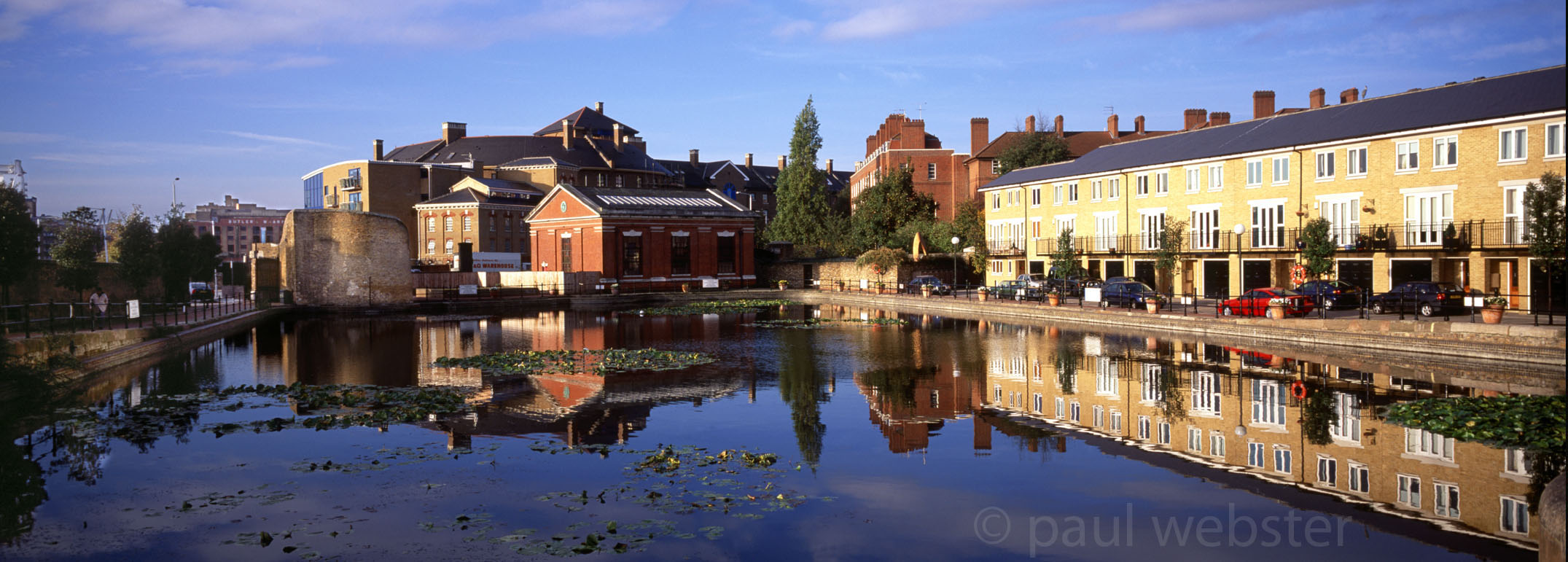
2002. London Docks
Hermitage basin redeveloped but still the old custom house stands as a sculptor's studio but the old dock walls have almost vanished. A private housing development stands at the edge of what is now an ornamental lake.
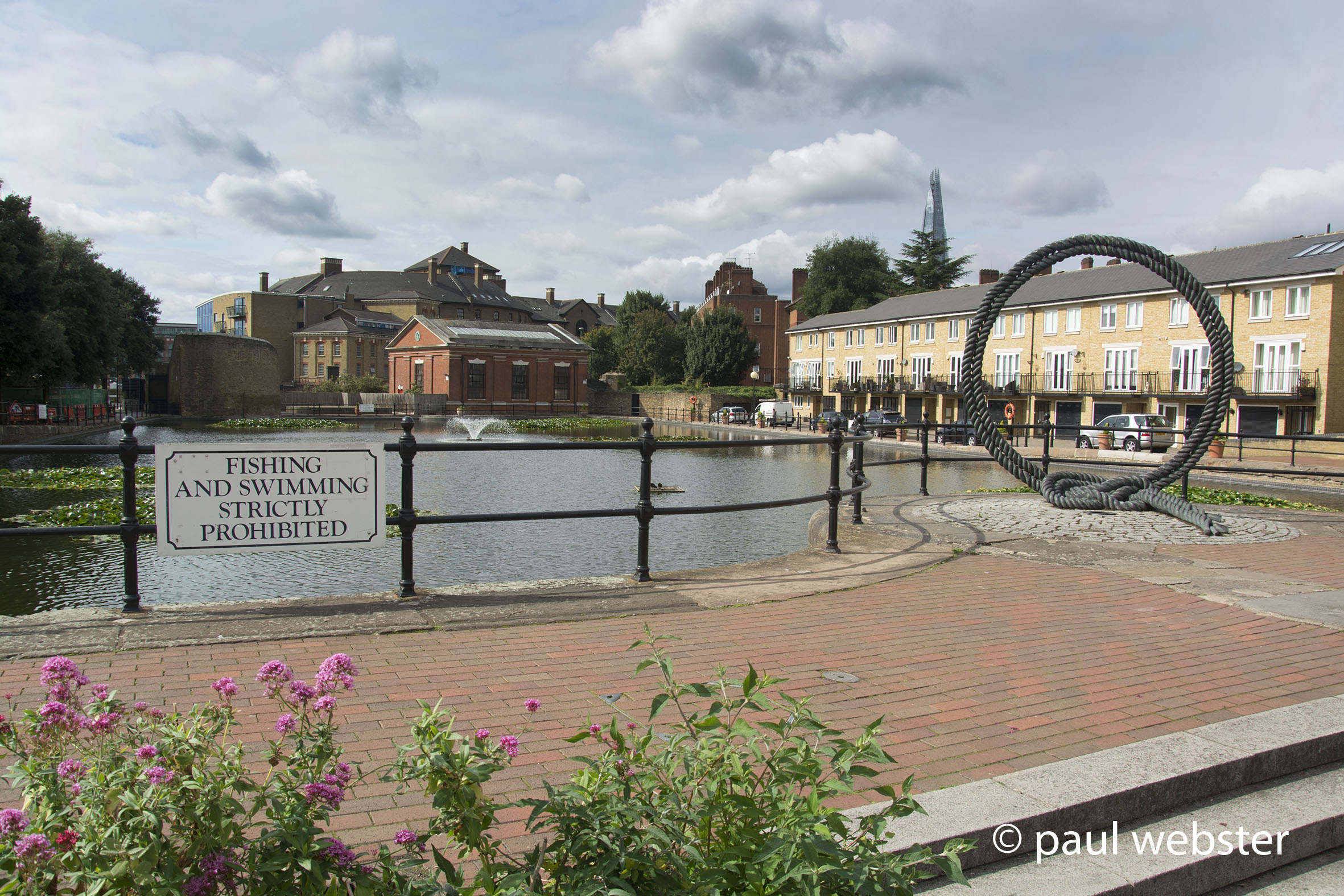
2018. London Docks
The customs house in Hermitage Basin was bought by Wendy Taylor C.B.E. a renowned sculptor whose works also appear nearby, the sundial at the Tower Hotel in St. Katharine’s dock and also in the adjacent memorial park. The housing alongside the dock is now a gated community.

1972. London Docks
West view of London main dock with a large number of the old warehouses still standing and one end of Tower Bridge and the Tower hotel visible in the distance.
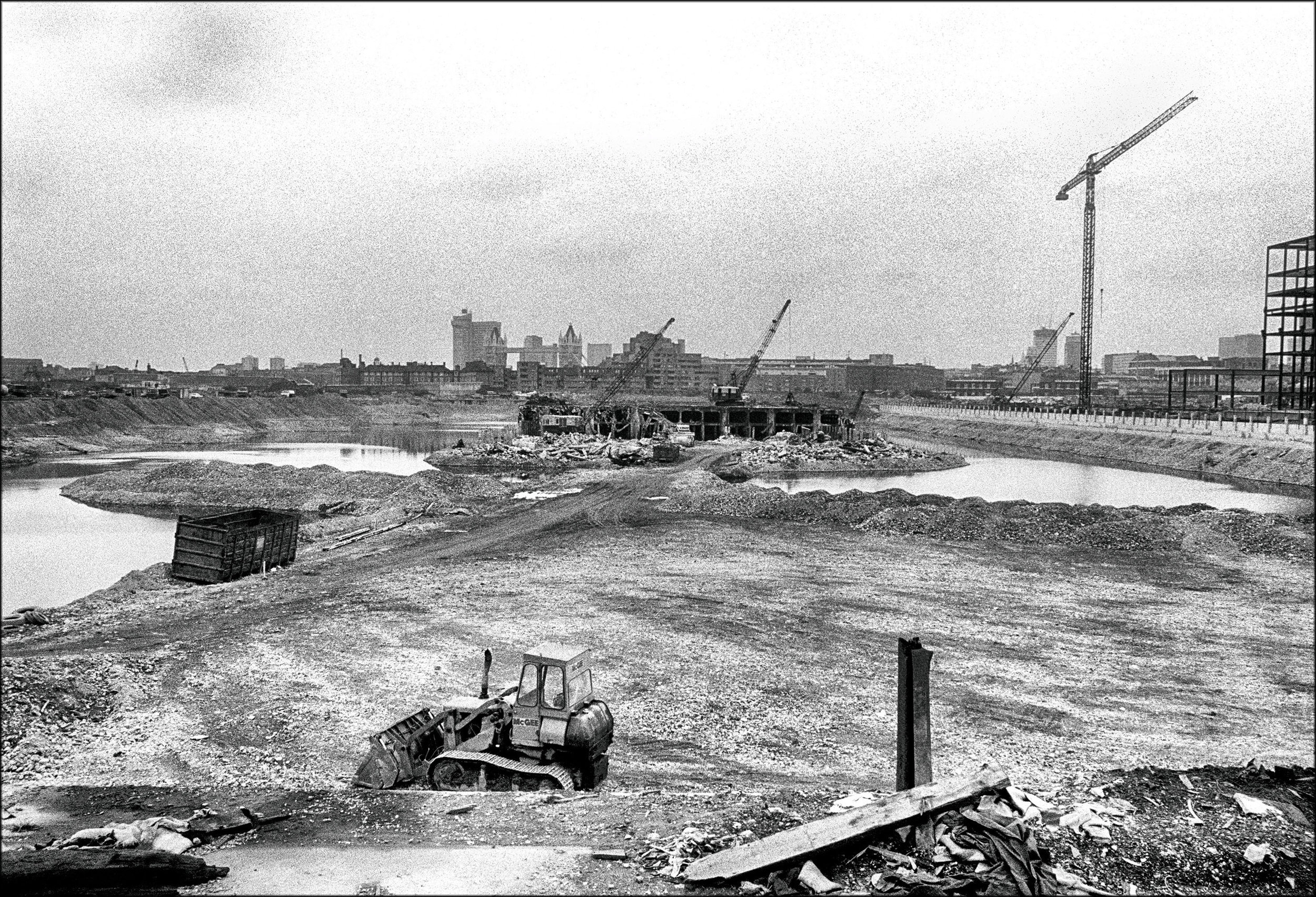
1982. London Docks
London main docks being filled ready for redevelopment after all the original warehouses had been demolished, to the right the News International development, where the infamous Wapping disputes took place, is being constructed.
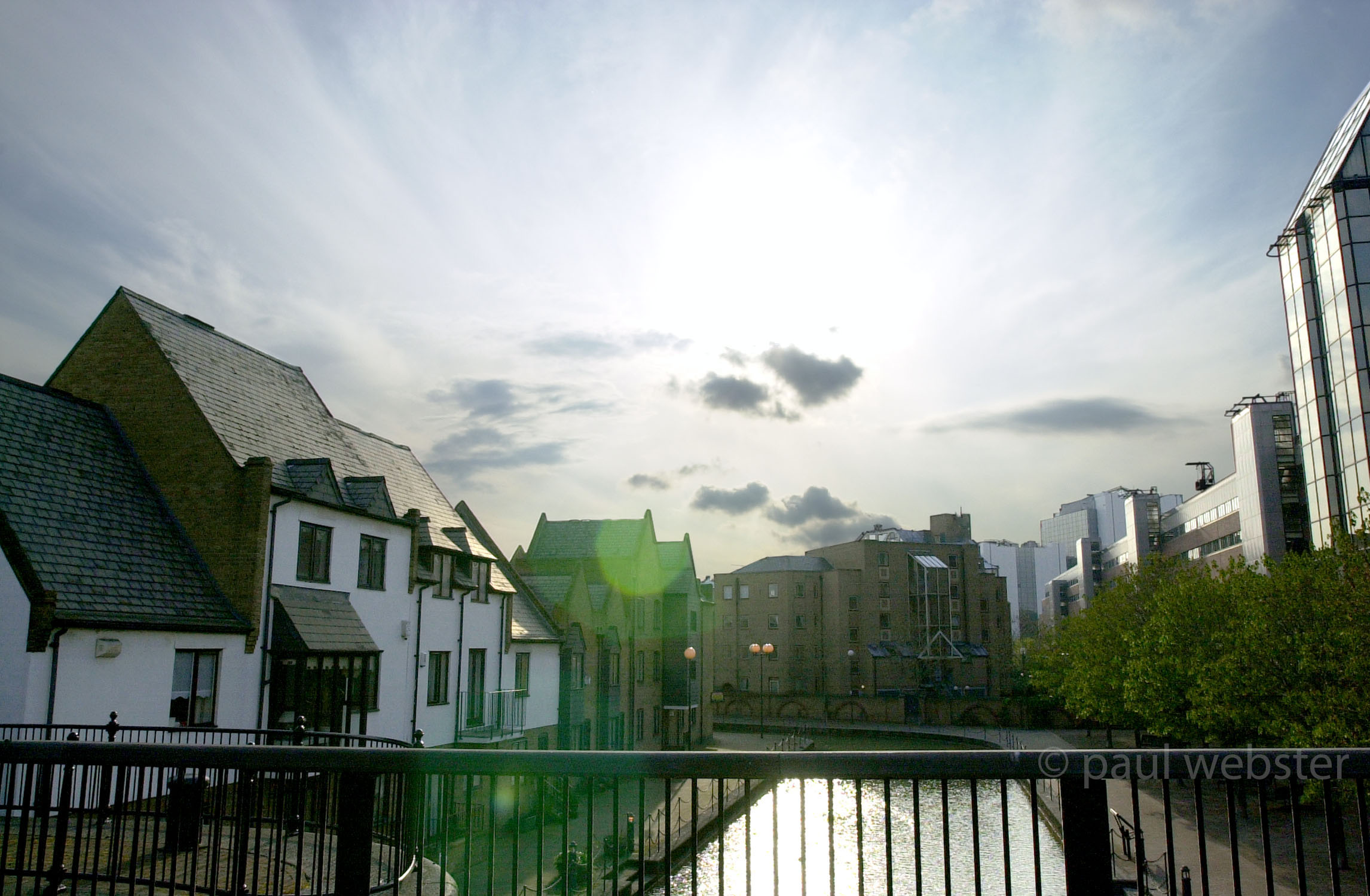
2002. London Docks
The new developments on the site of the old London main dock and to the right the News International print works.
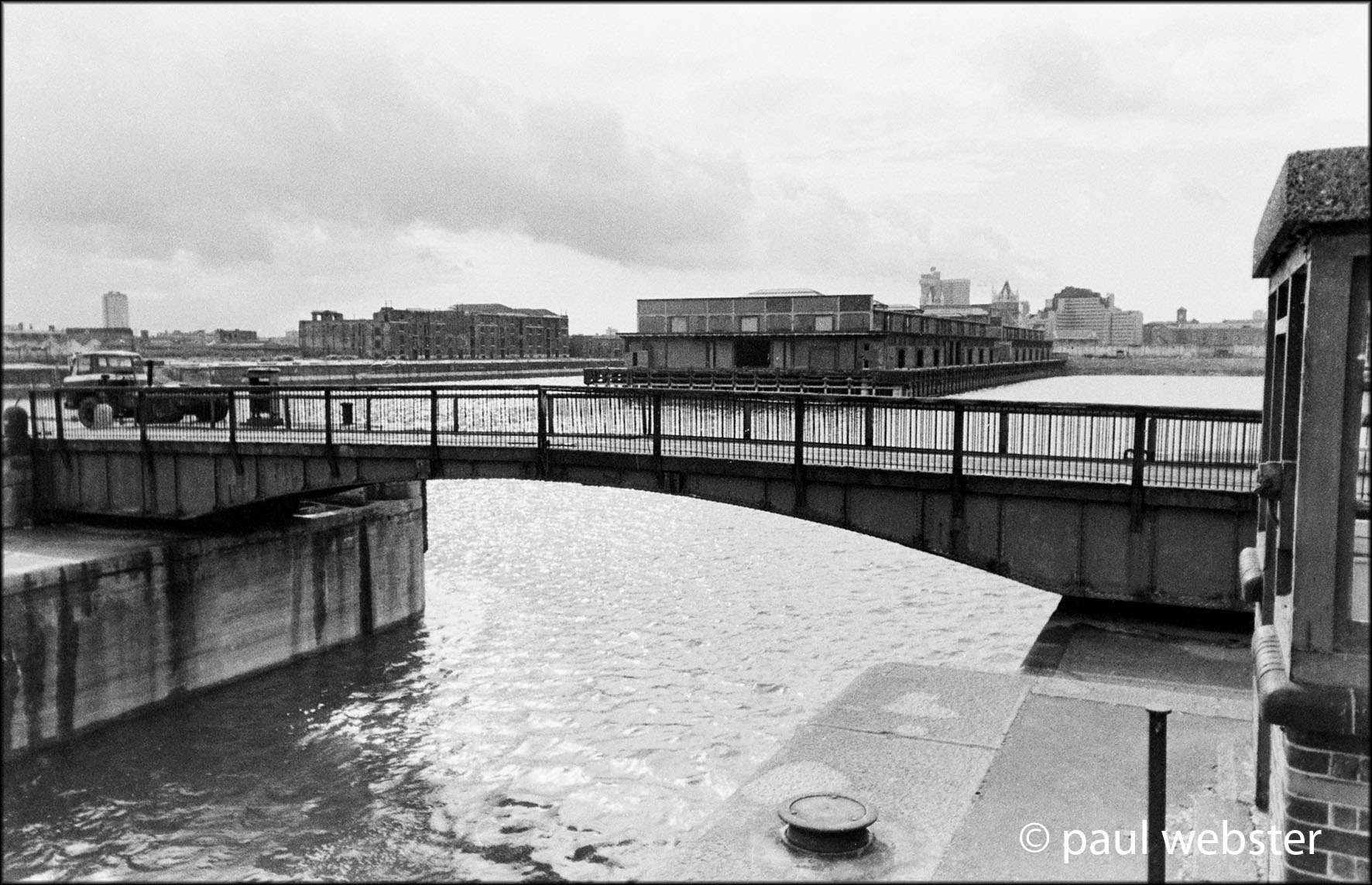
1972. London Docks
View from bridge at Tobacco Dock looking West over London Dock.
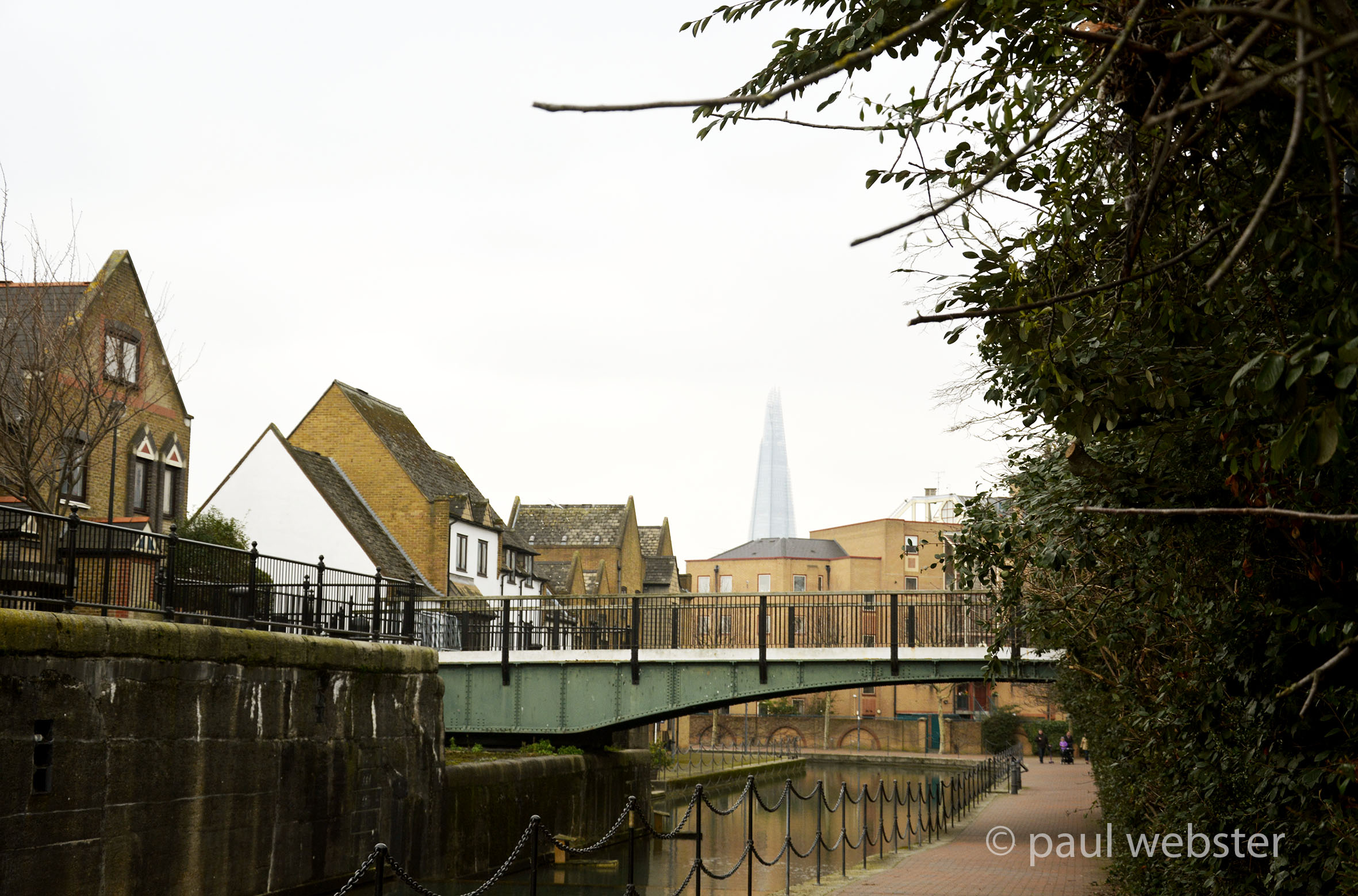
2018. London Docks
The bridge which used to allow merchant vessels access from Wapping to Middle London Dock past Tobacco Dock is now blocked off and unused. The north side is very overgrown and the ornamental canal underneath leads to what used to be London Main Dock and is now homes and parking.
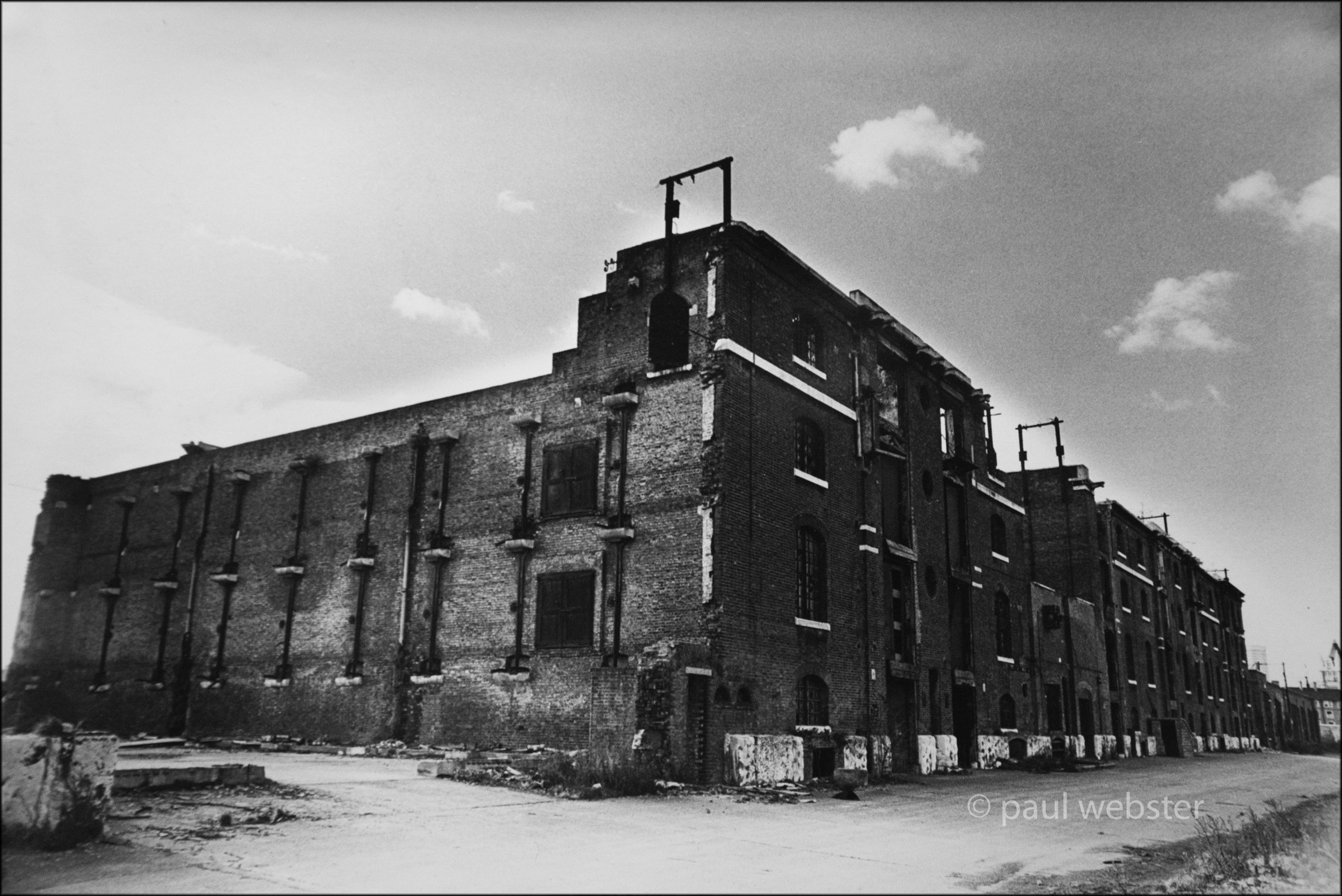
1971. London Docks
These Western dock warehouses and cellars were home to the imported spirits that were a large proportion of the high value cargoes delivered into London Dock until it was closed in 1969.
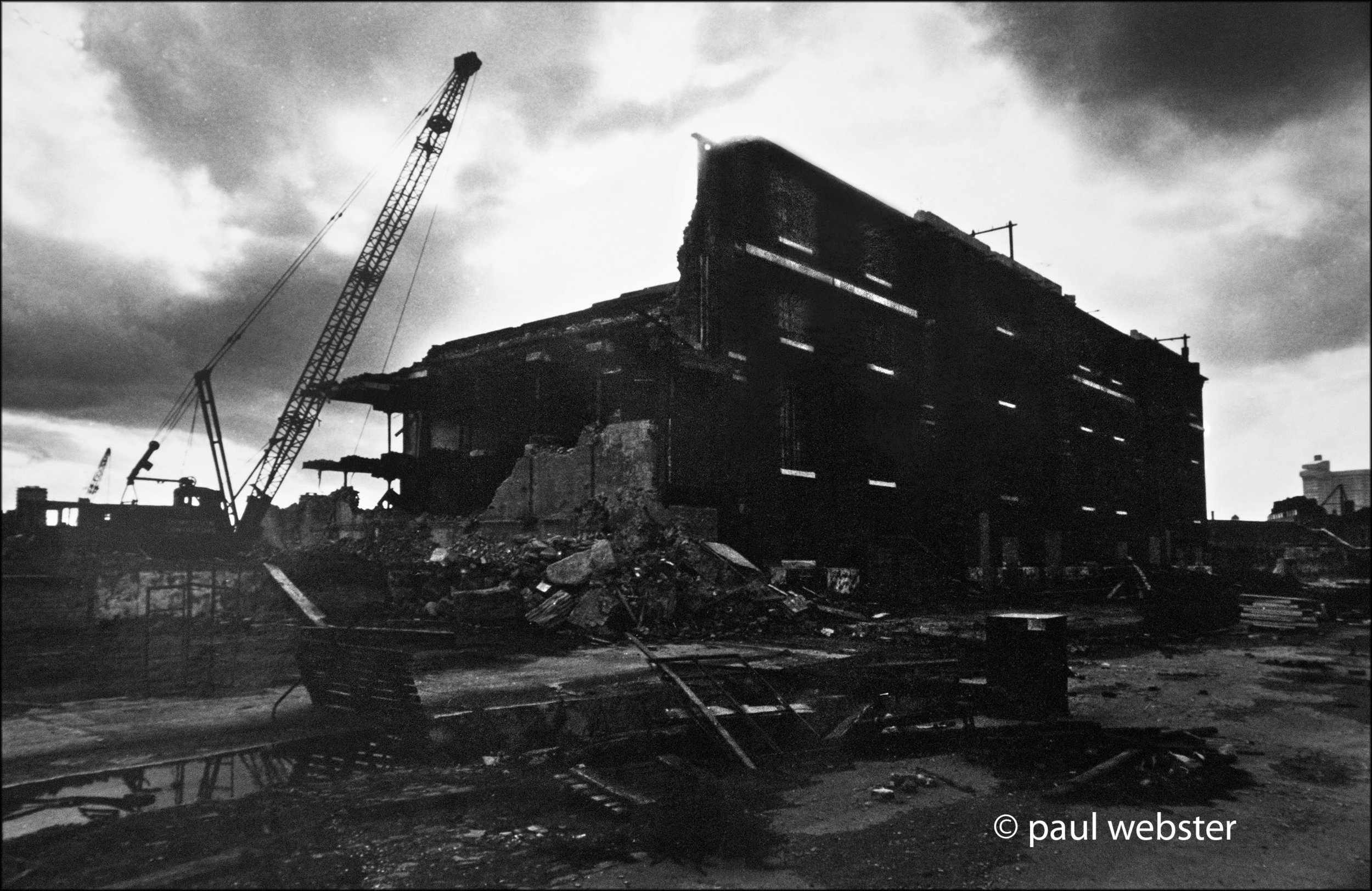
1980. London Docks
Demolition of Old Warehouses
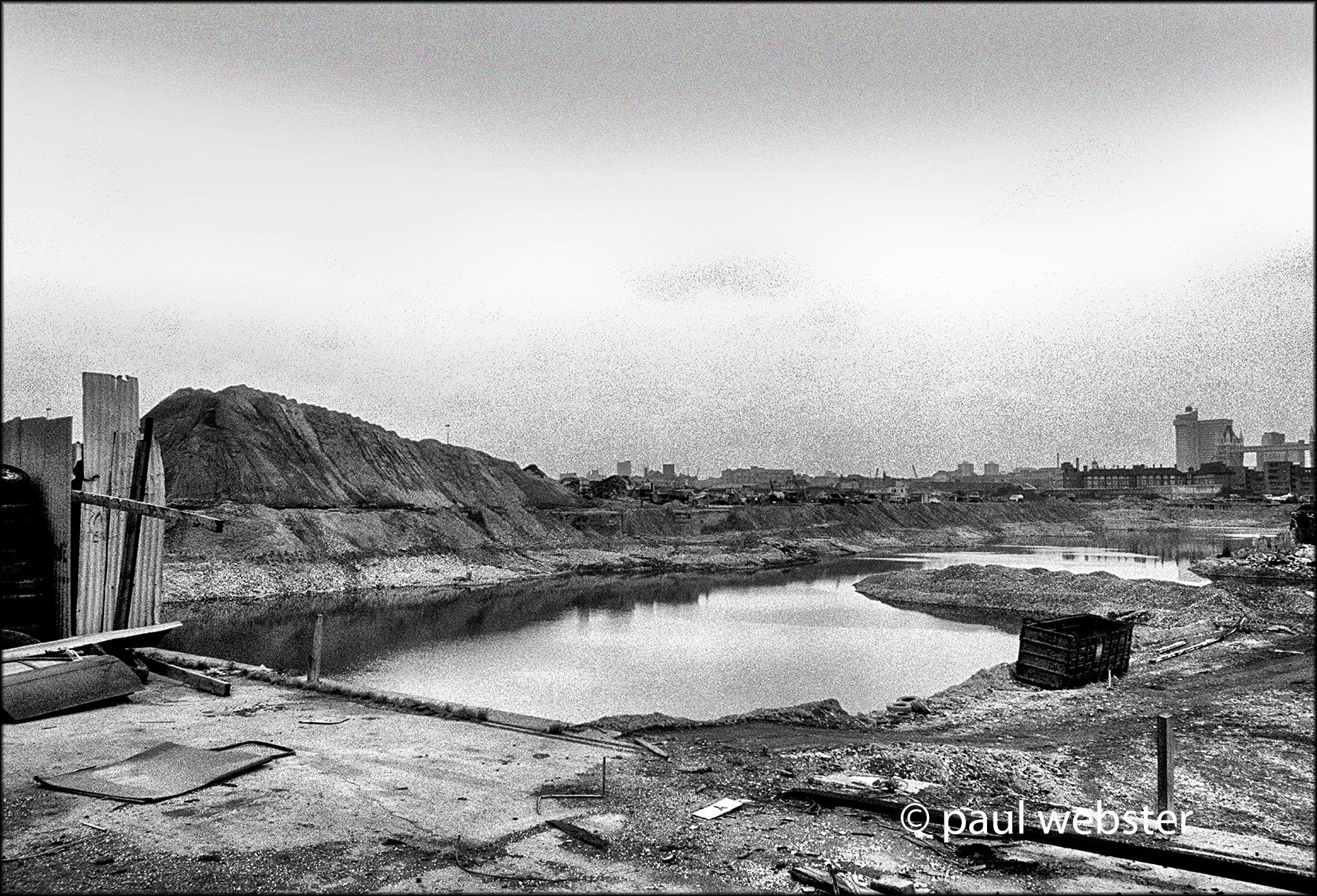
London Dock warehouses disappeared.
1982. All the original London Dock warehouses are now gone and serious preparations are being made for new housing and ornamental canals to replace these old docks.
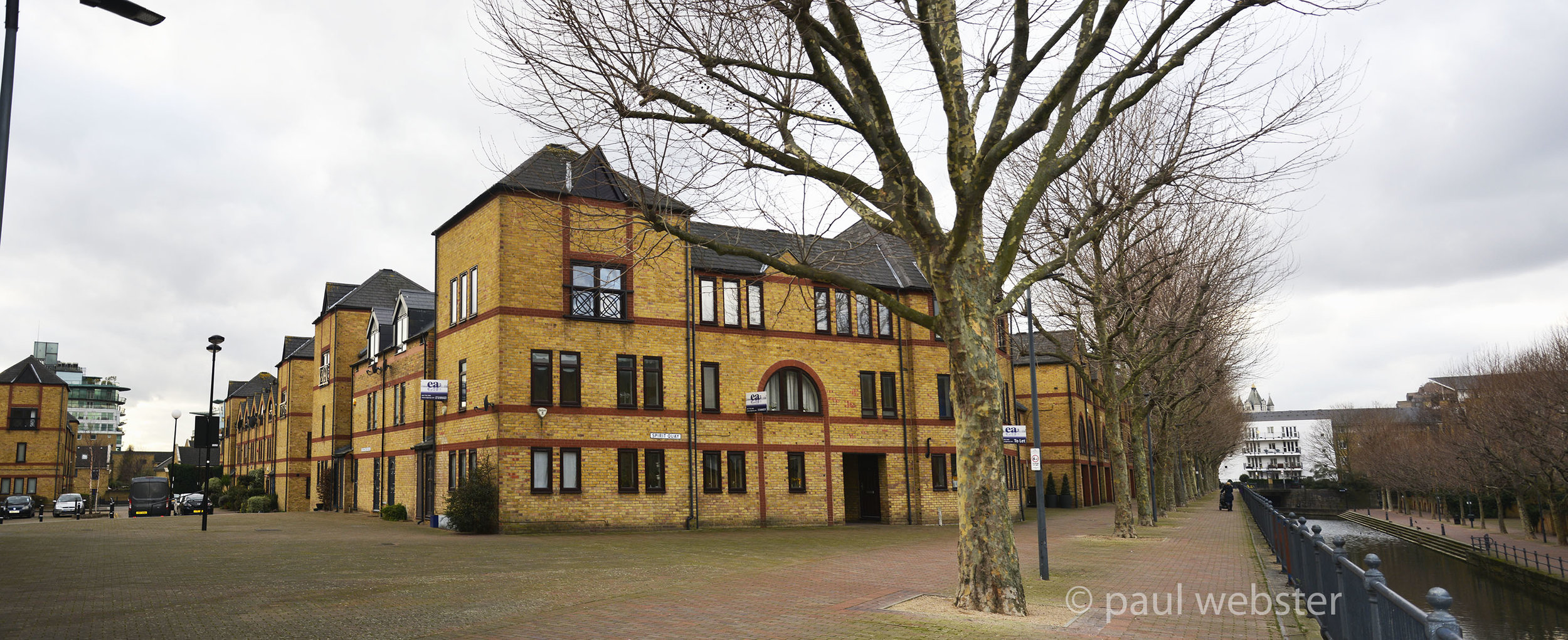
2018. London Docks
The new housing has taken onboard the character of the old stock, this is now Spirit Quay.
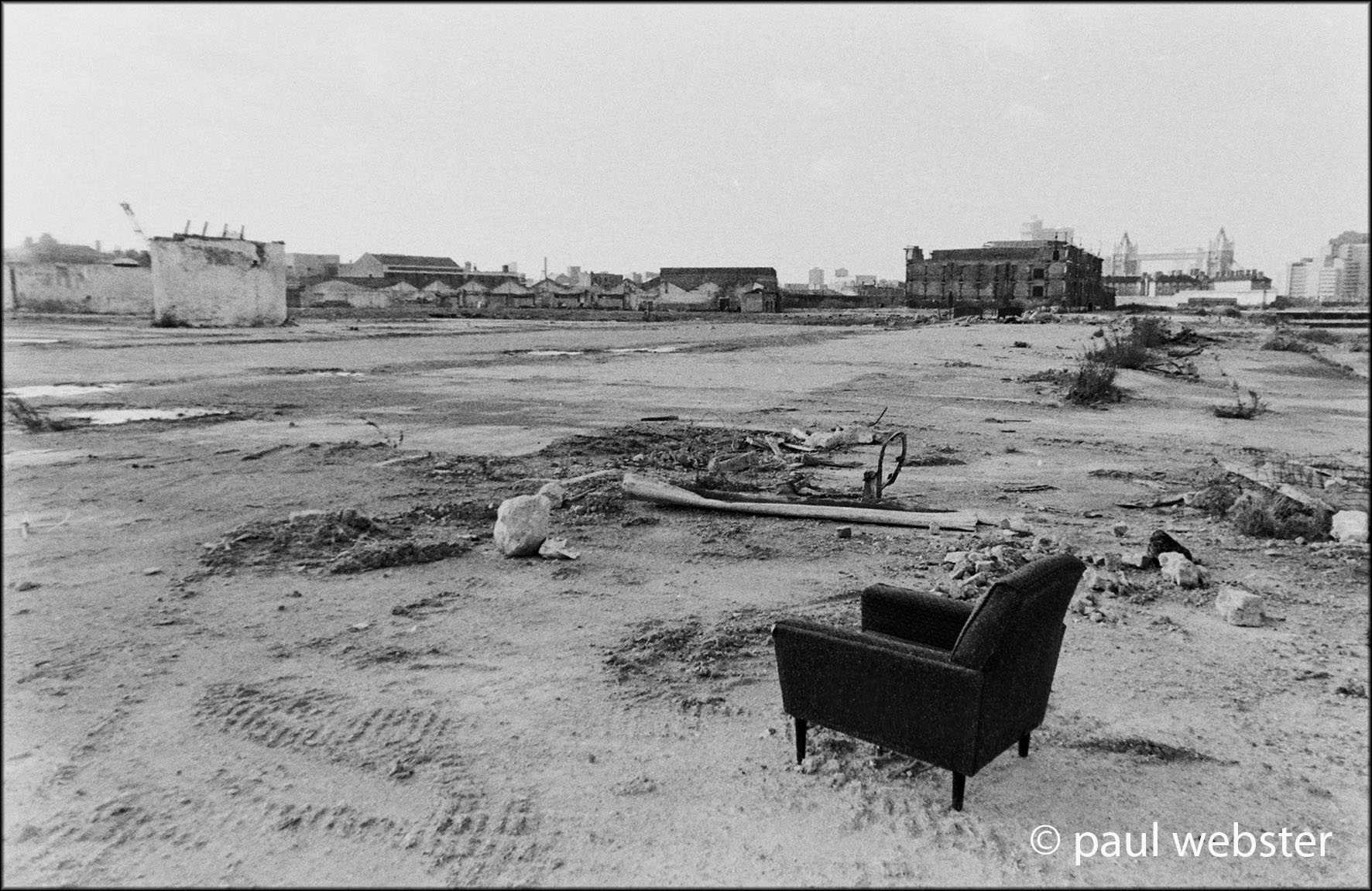
1971. London Docks
Another entrance to the London Dock was through Wapping basin which by 1971 was completely filled and ready for redevelopment.
The Western warehouses are visible with Tower Bridge in the distance.

2018. London Docks
Housing developments in place of docks and an entrance to the old Wapping basin preserved. Tower Bridge skulking behind a tree.
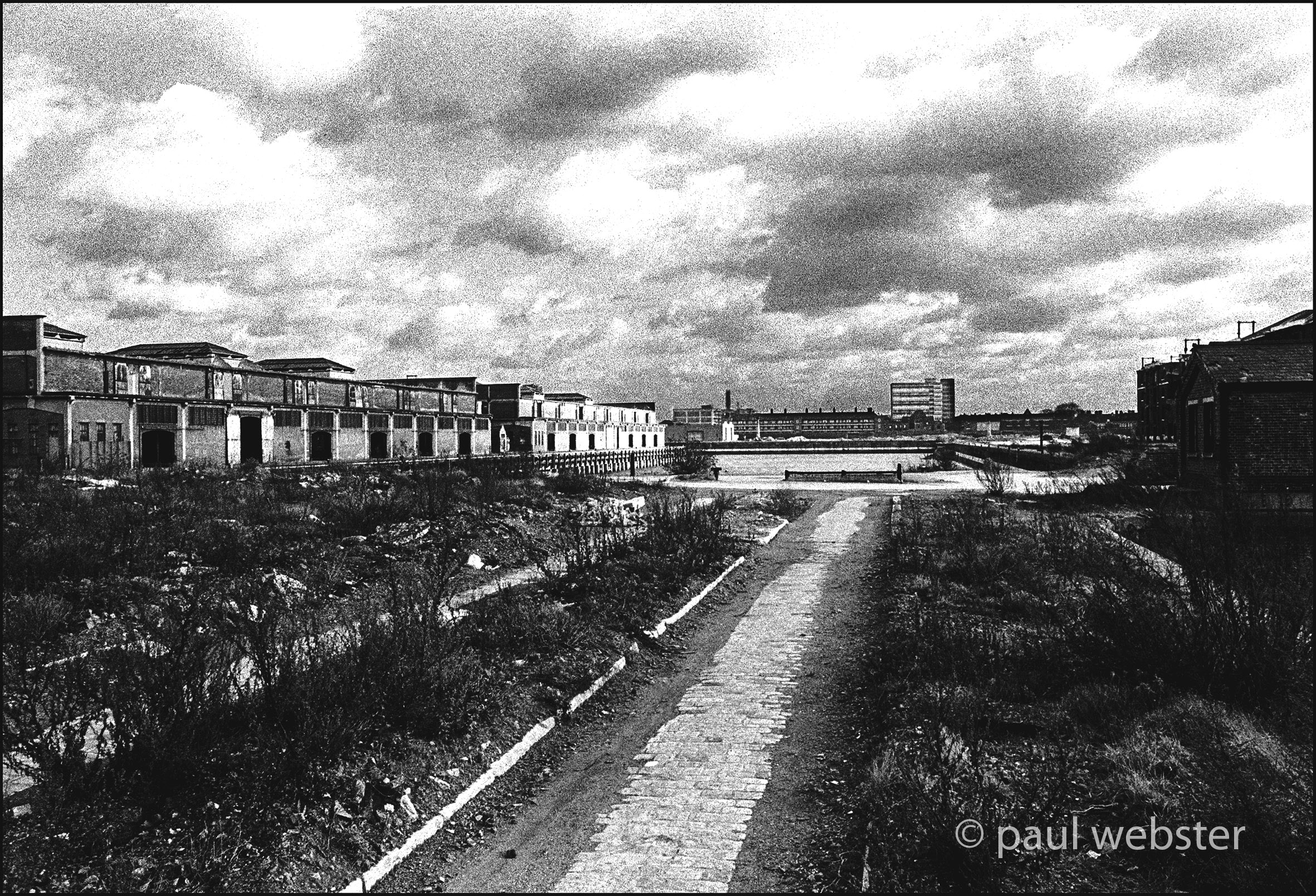
1971. London Docks
Looking east across London main dock , where some of the larger warehouses have already gone, to those that still decay alongside the water.
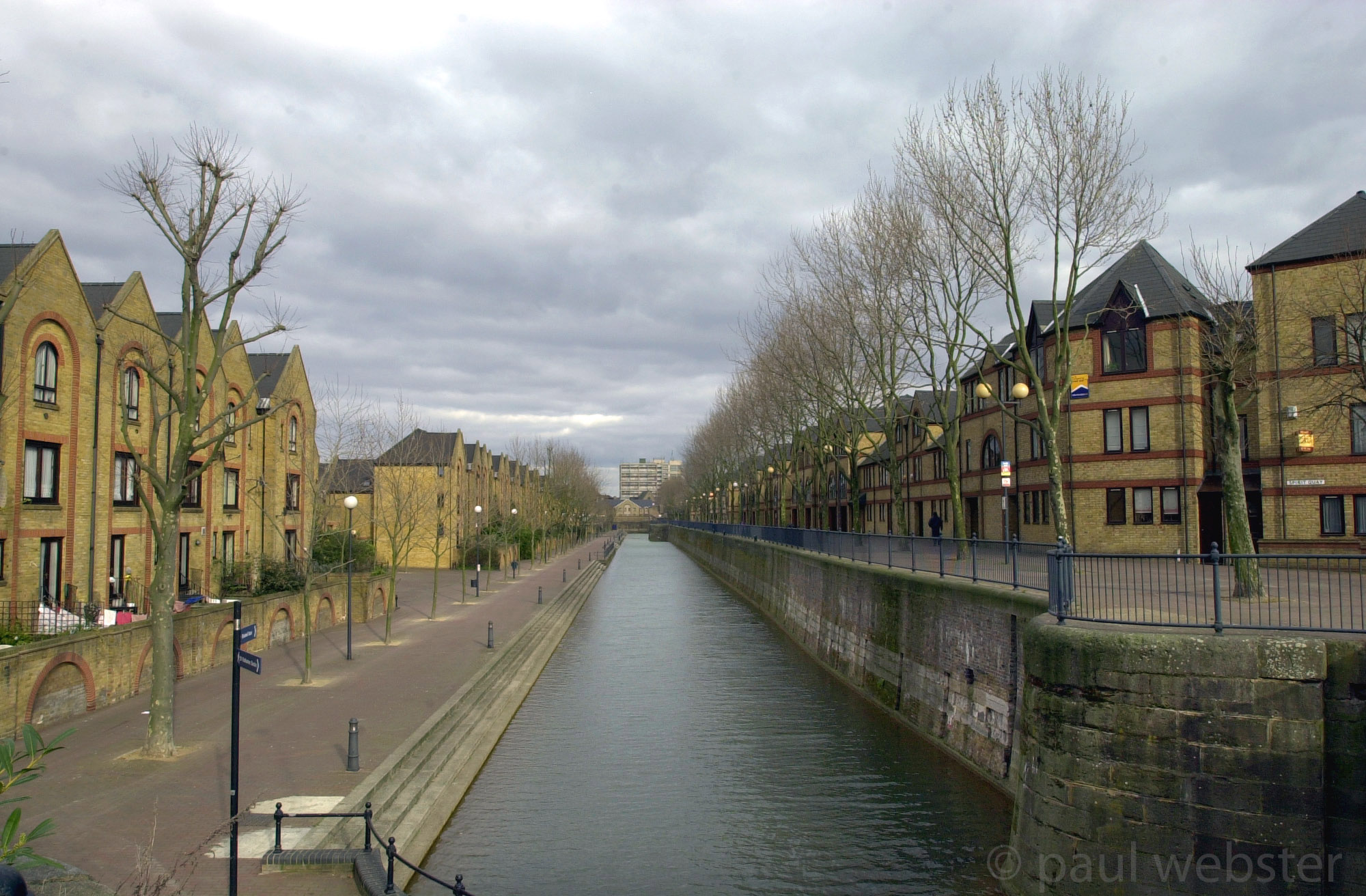
2002. London Docks
An eastward view showing the retention of the old dock wall from London main dock and the many dwellings alongside what is now only a channel.
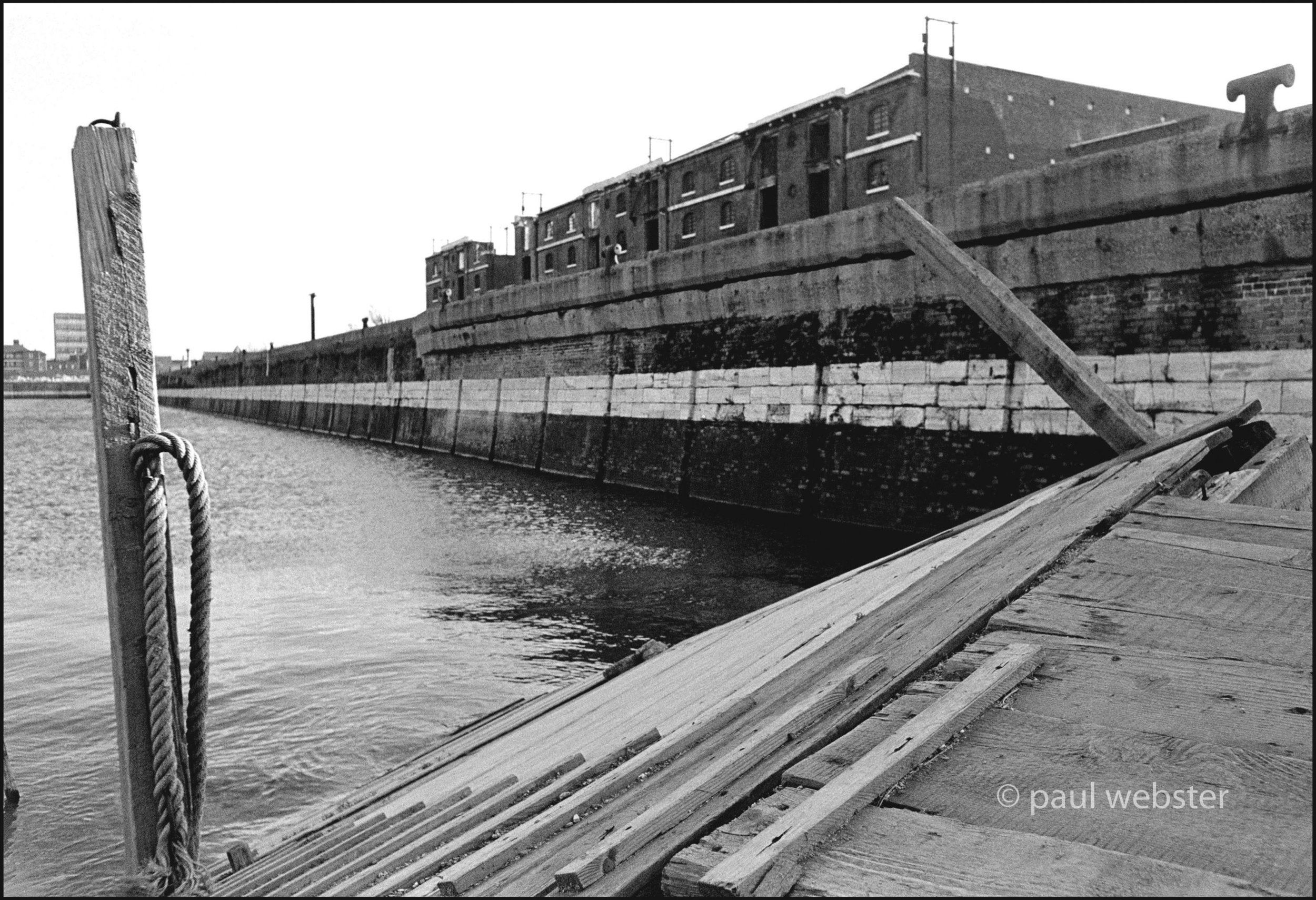
1971. London Docks
South Quay warehouses looking east.
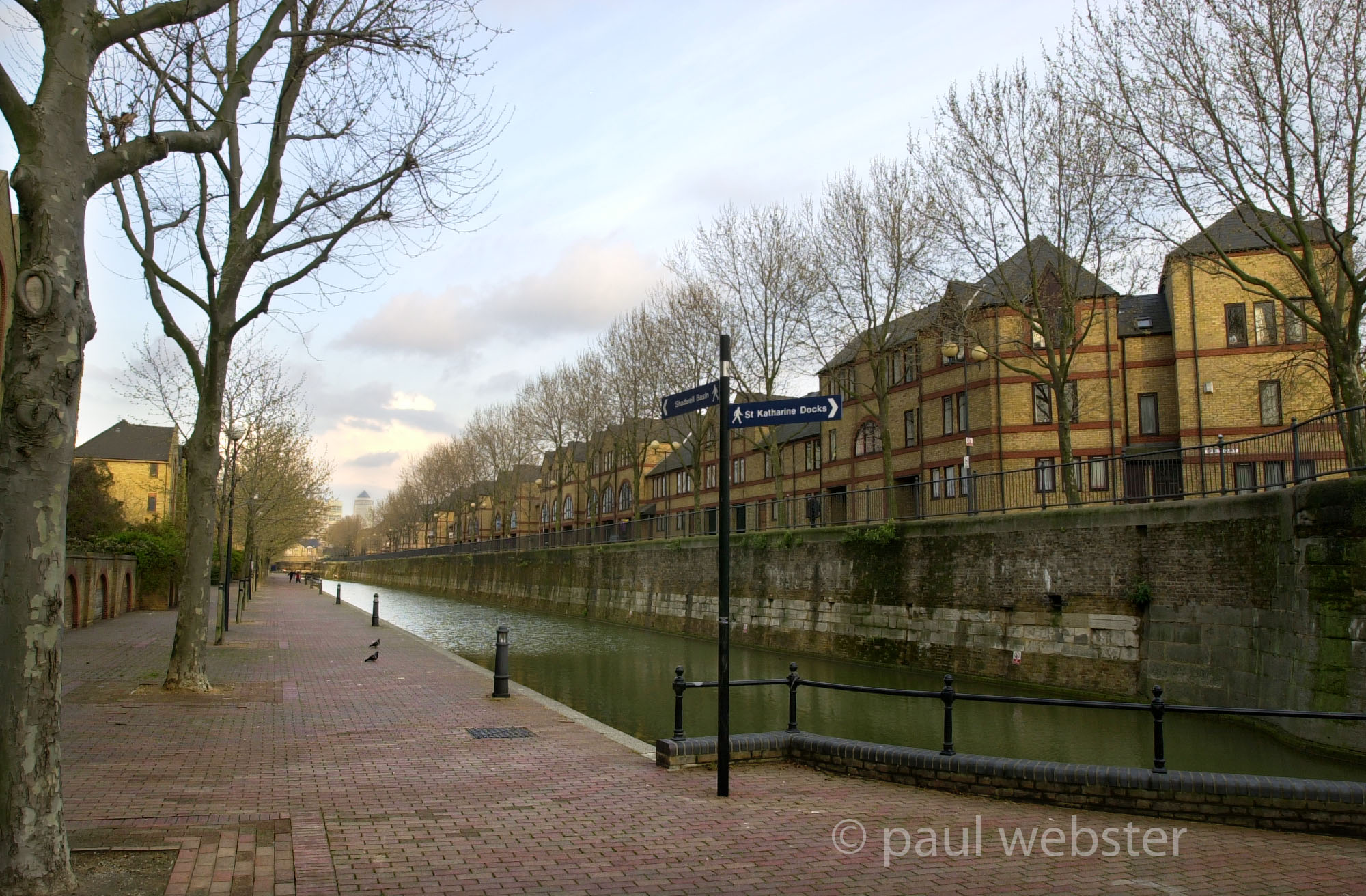
2018. London Docks
The new blocks of flats standing on South Quay with the old dockside wall still standing
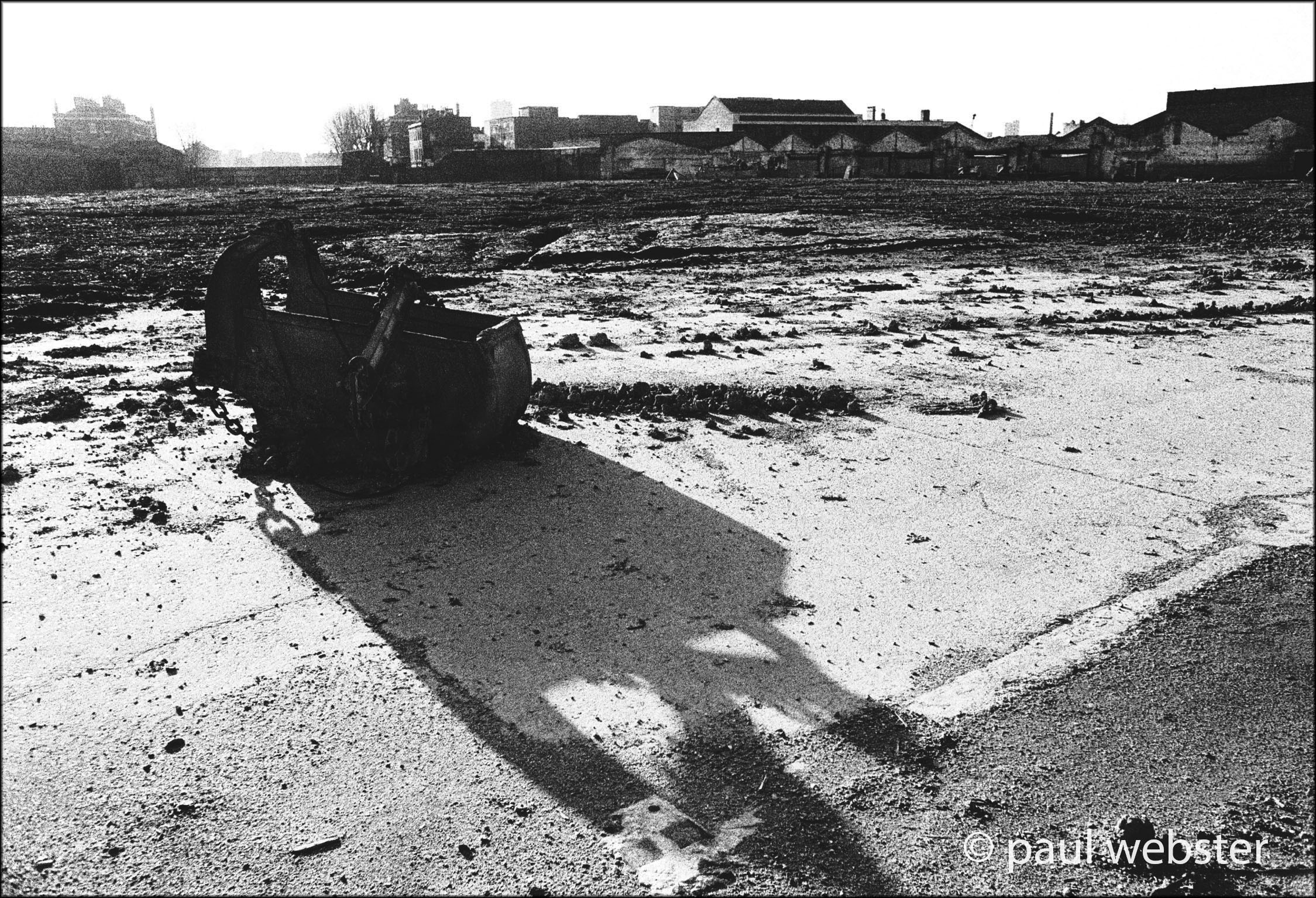
1972. London Docks
Wapping basin branched out from London's main dock to provide a good sized entrance from the Thames but by the time I arrived had been filled in ready for conversion. The old entrance with houses either side is barley visible over the top of the digger shovel.
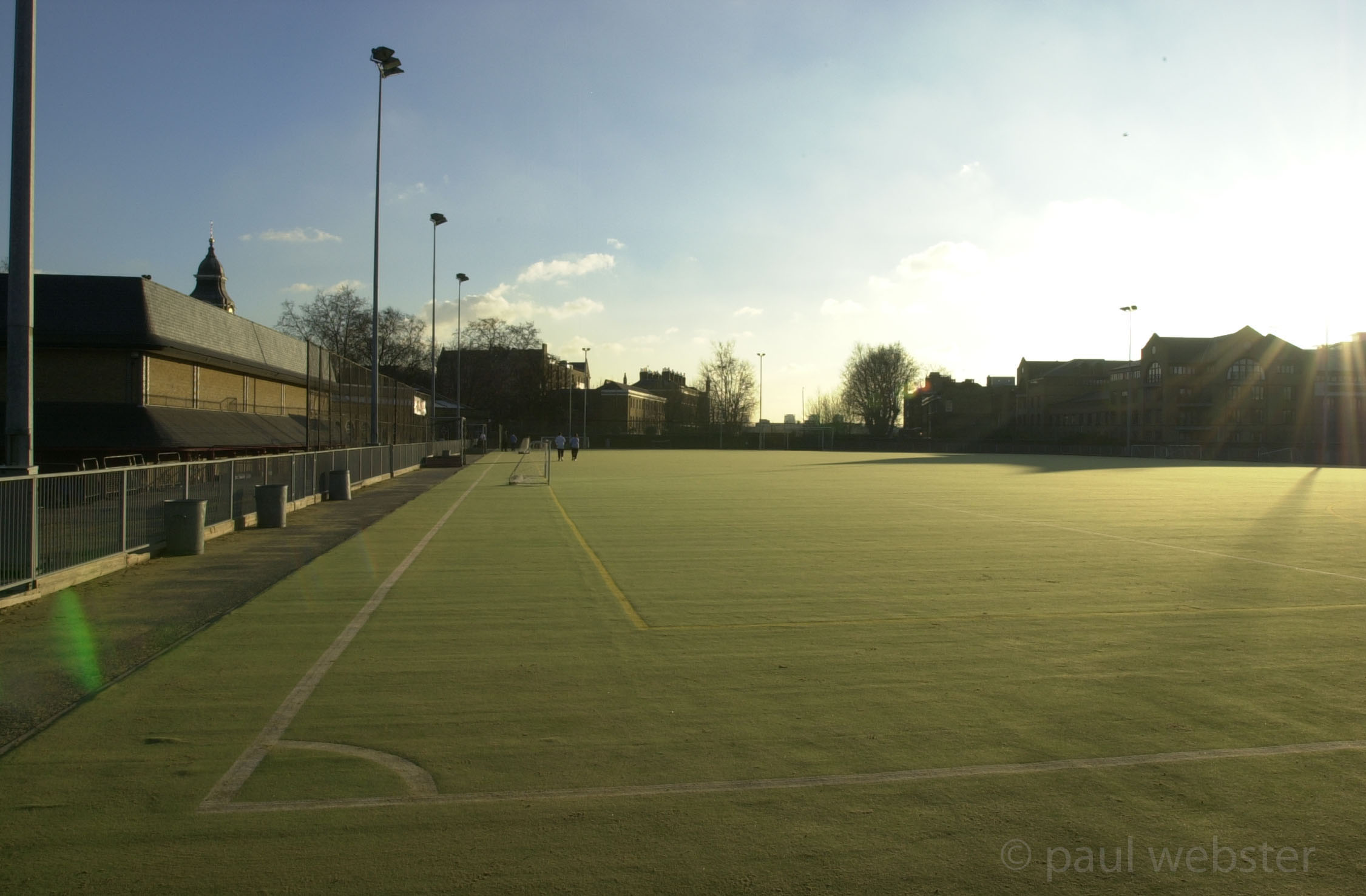
2002. London Docks
In the heart of old Wapping, some of the dereliction of the seventies has been swept under a neat, green astroturf carpet. The open space next to the baroque tower of the church of St.John was once crowded with houses. German bombs made the space available for lunchtime footie and netball.

2018. London Docks
The sports facilities next to the astroturf have expanded and are now John Orwell sports facility though the the old Wapping dock walls still stand at the far end where ships once entered but only surround the car park. The spice factory outside the walls has been turned into residential housing part of the area’s gentrification.

1972. London Dock
The last standing tobacco warehouse in Wapping dock now finding a new plant growing, marijuana! Possible the product of seeds from afar!!
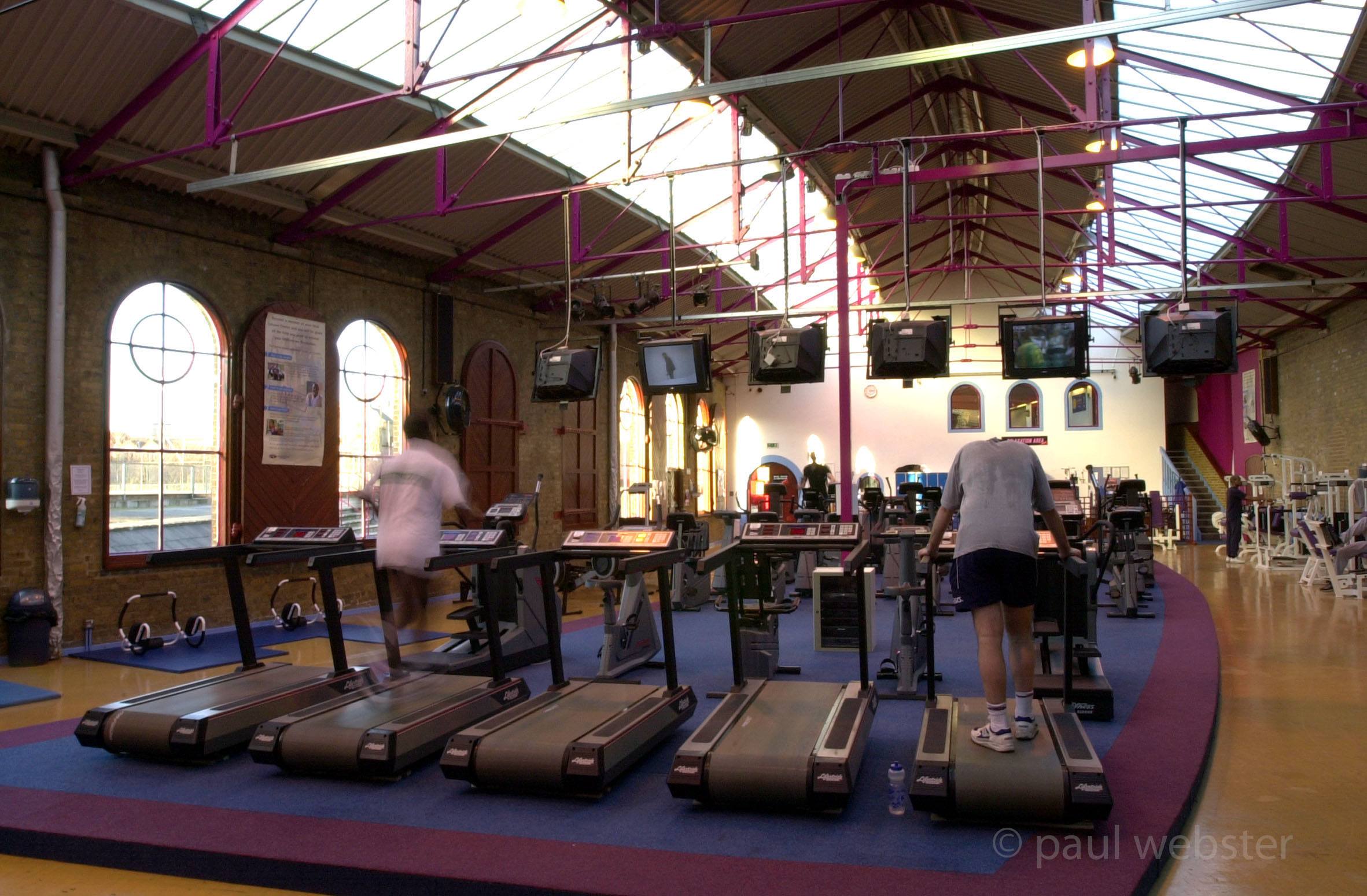
2002. London Dock
A perfect site for a sports club in Wapping.
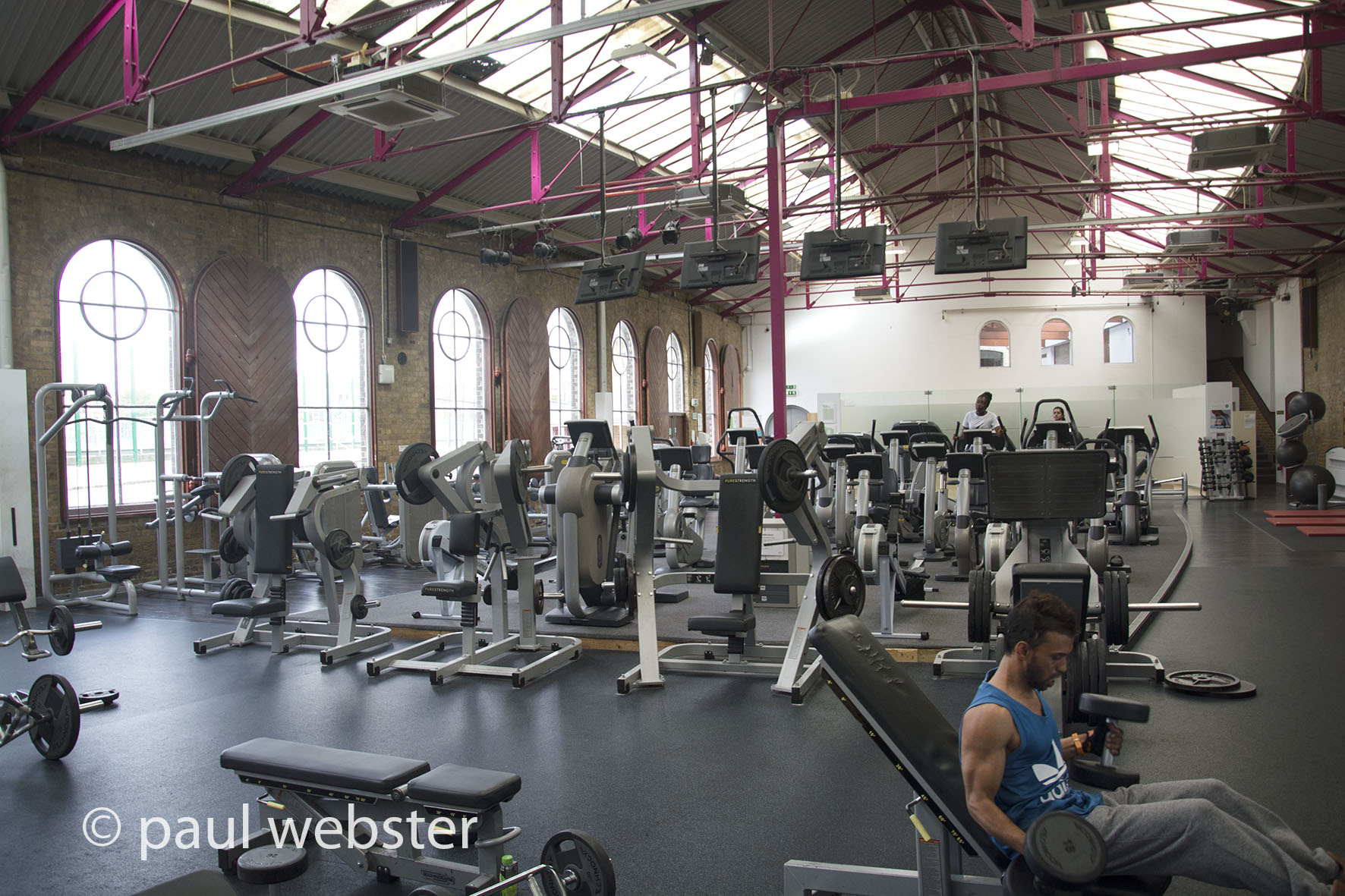
2018. London Docks
Now the old Wapping warehouse has become the John Orwell Sports centre in conjunction with Tower Hamlets Council.
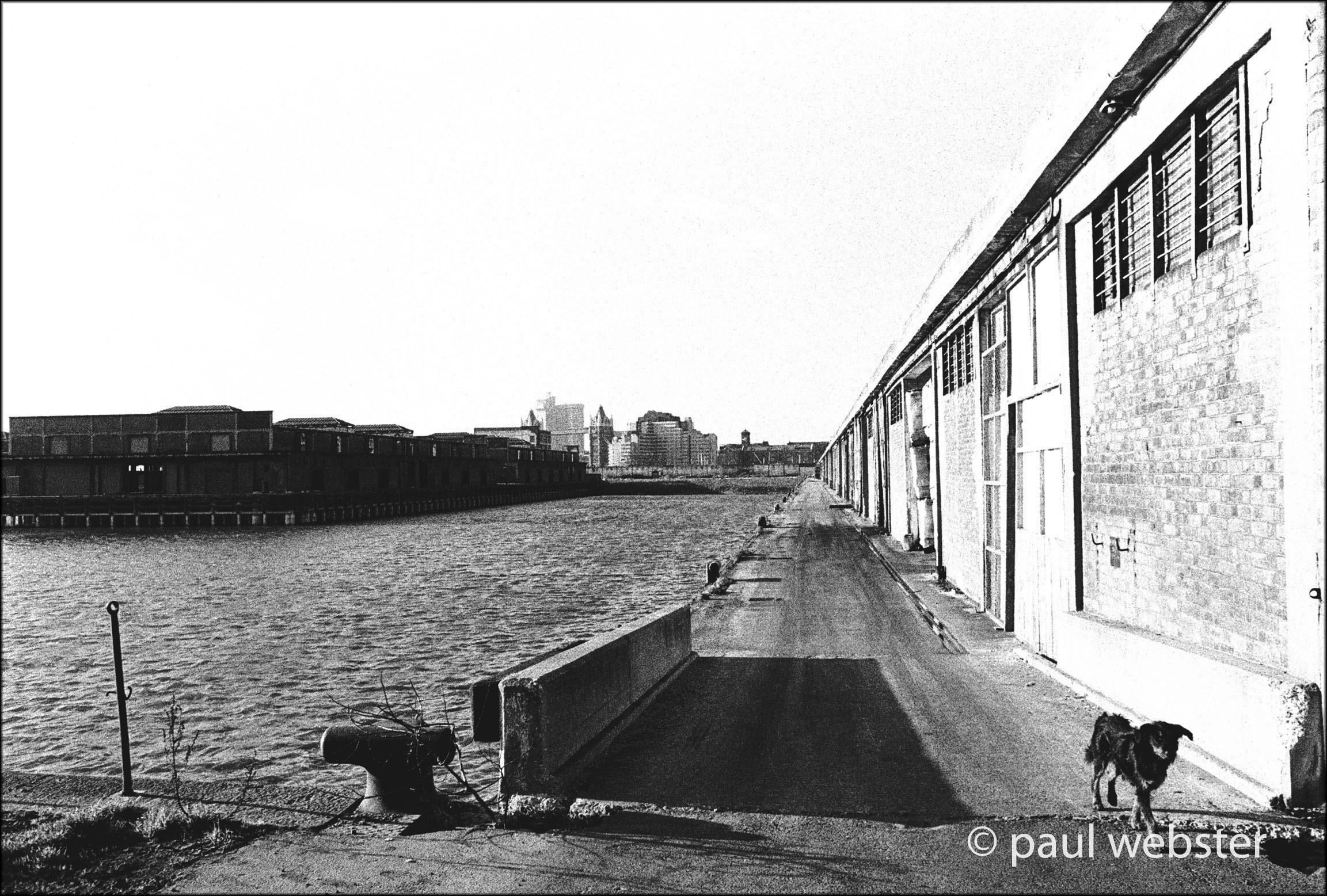
1972. London Docks
Tower Bridge in the distance from the perspective of the old main dock north warehouse adjacent to Pennington st.

2002. London Docks
Great expanses of water were in-filled when the docks finally fell into disuse. The back wall of Fortress Wapping , News International’s newspaper offices and print works - was once the northern quayside of the vast Western dock. Now the location of the old quay is a matter of archaeology.
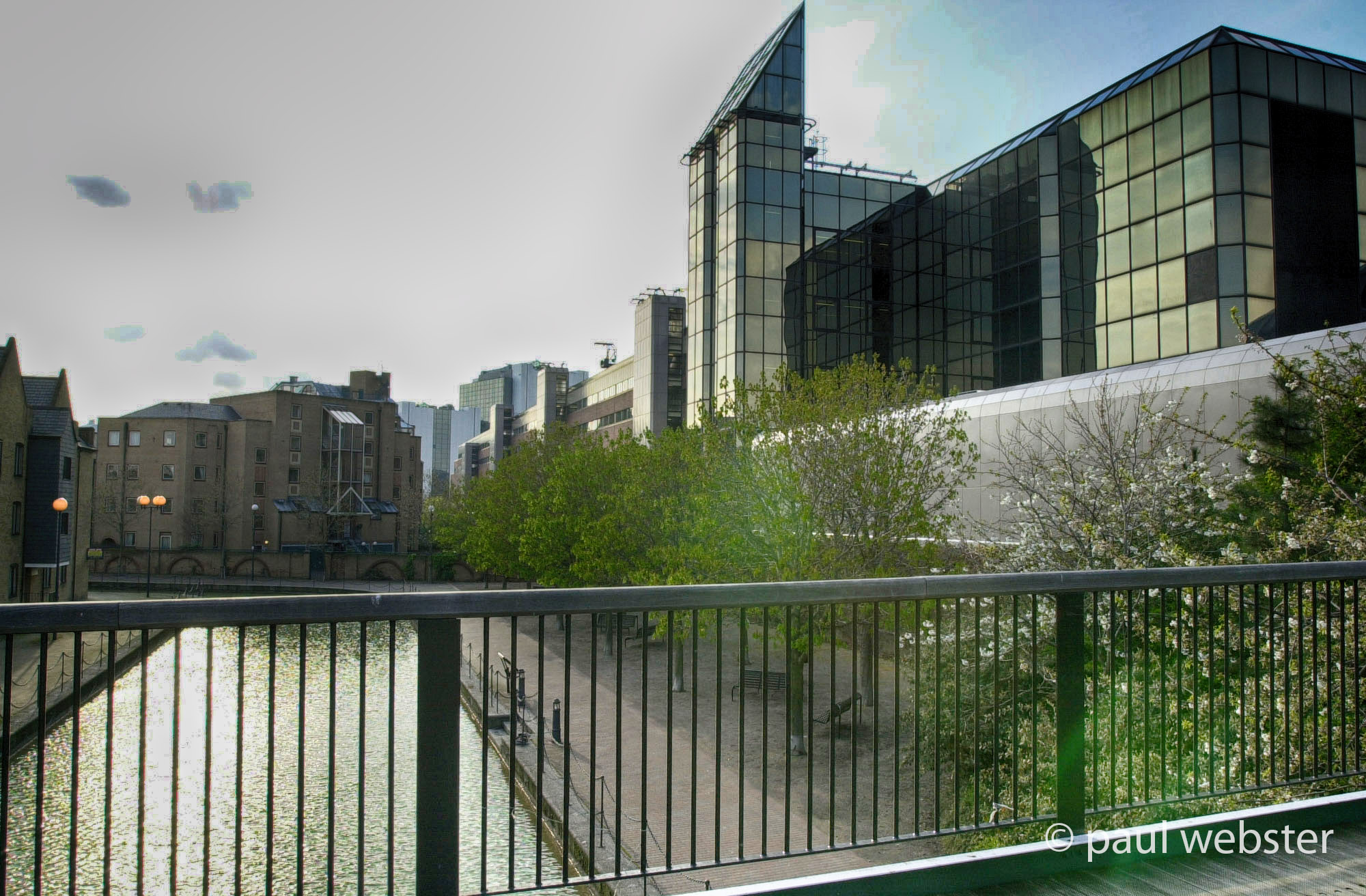
2002. London Docks
From Tobacco docks bridge towards the newly built News International print works and offices, the new residential quarter that was London Dock to the left.
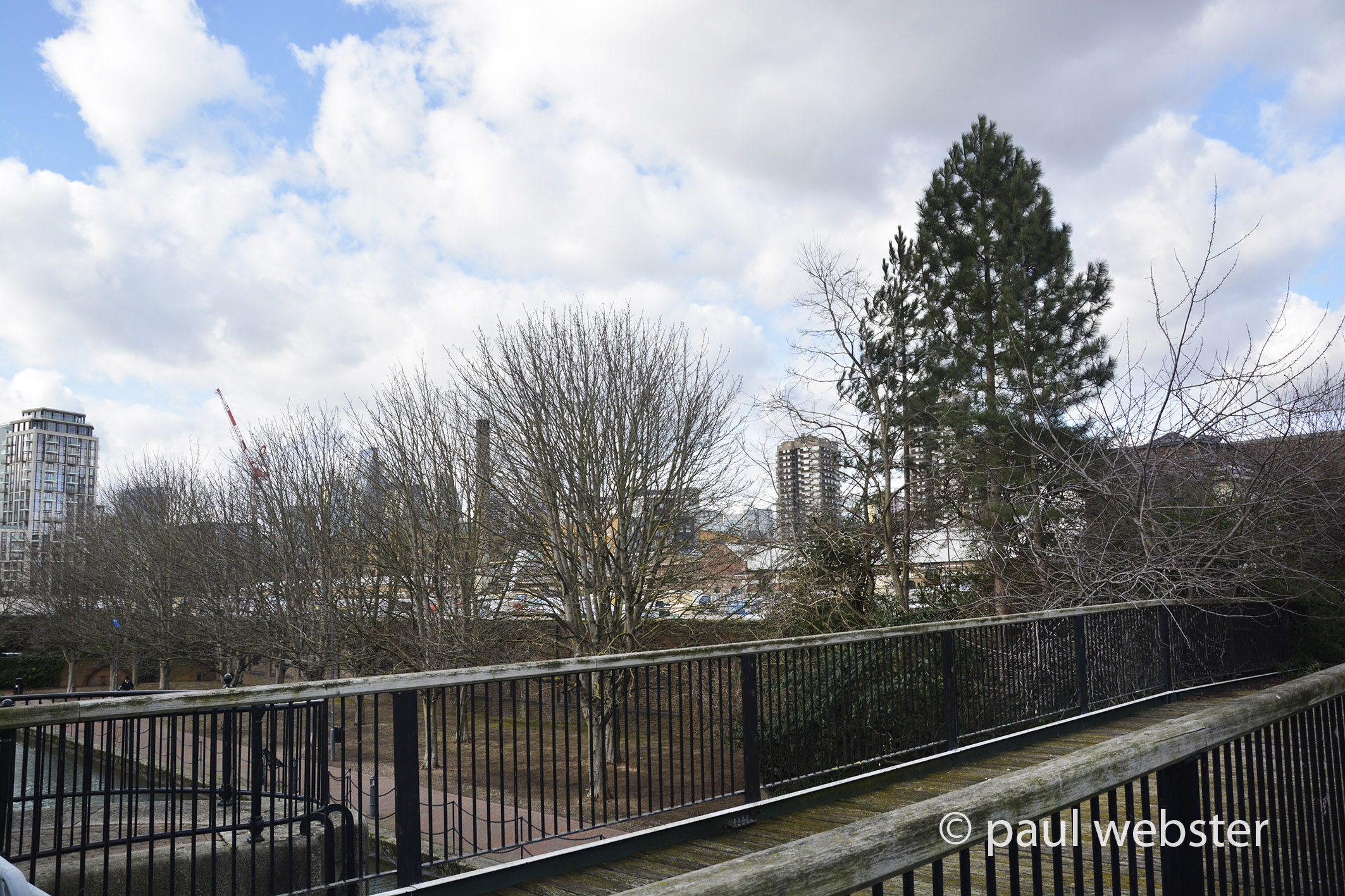
2018. London Docks
The development site where Pennington St. warehouses and the News International print works stood is becoming Wapping Village, more luxury housing and a new square.
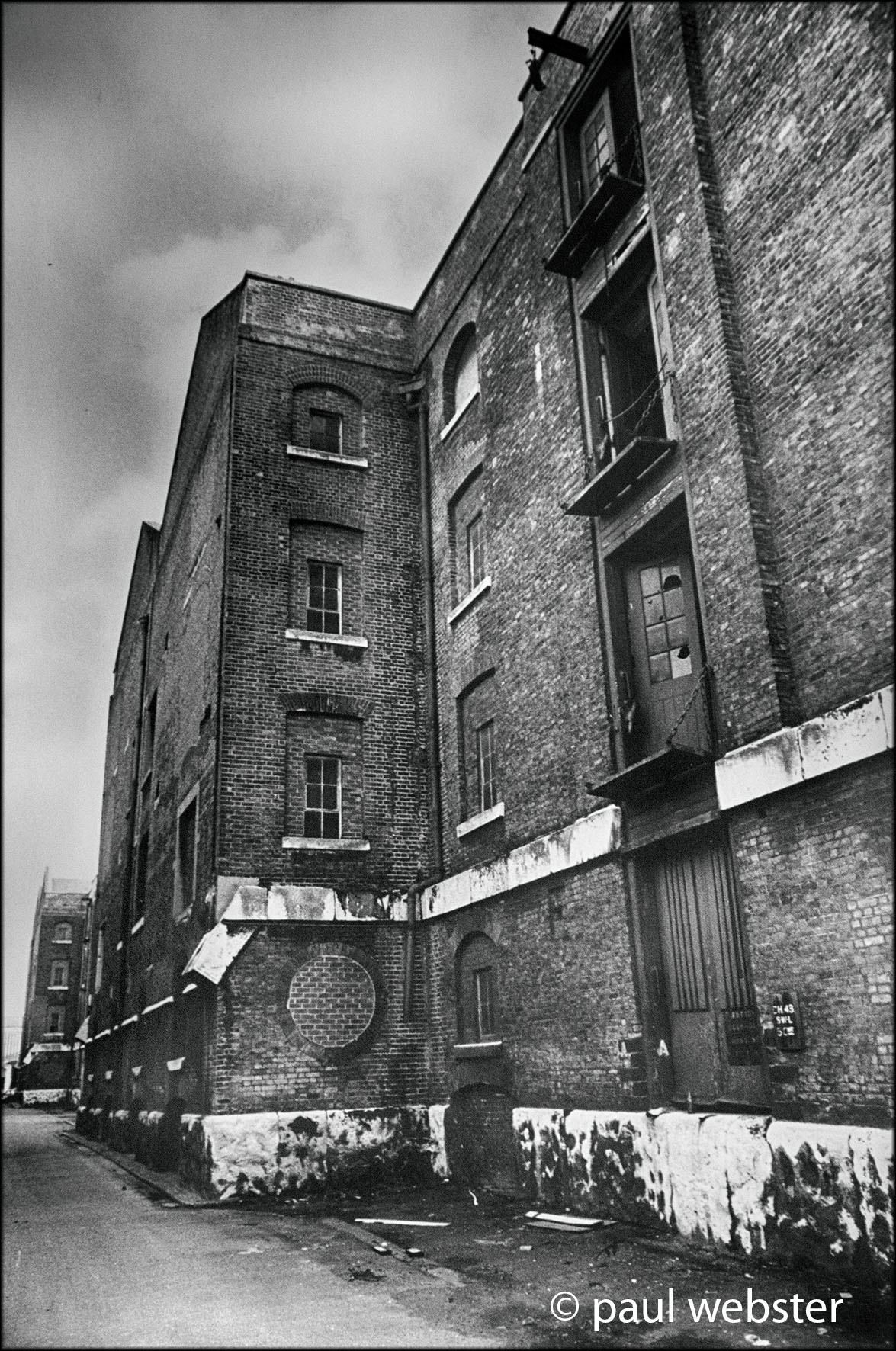
1971. London Docks
The main Pennington Street warehouses nos. 4 & 5 listed buildings looking eastward. Shortly afterwards they were destroyed by fire that had to have been set by a professional according to a local fire officer. They were replaced by the News International print works and offices.

1971. London Docks
Pennington St. warehouses.
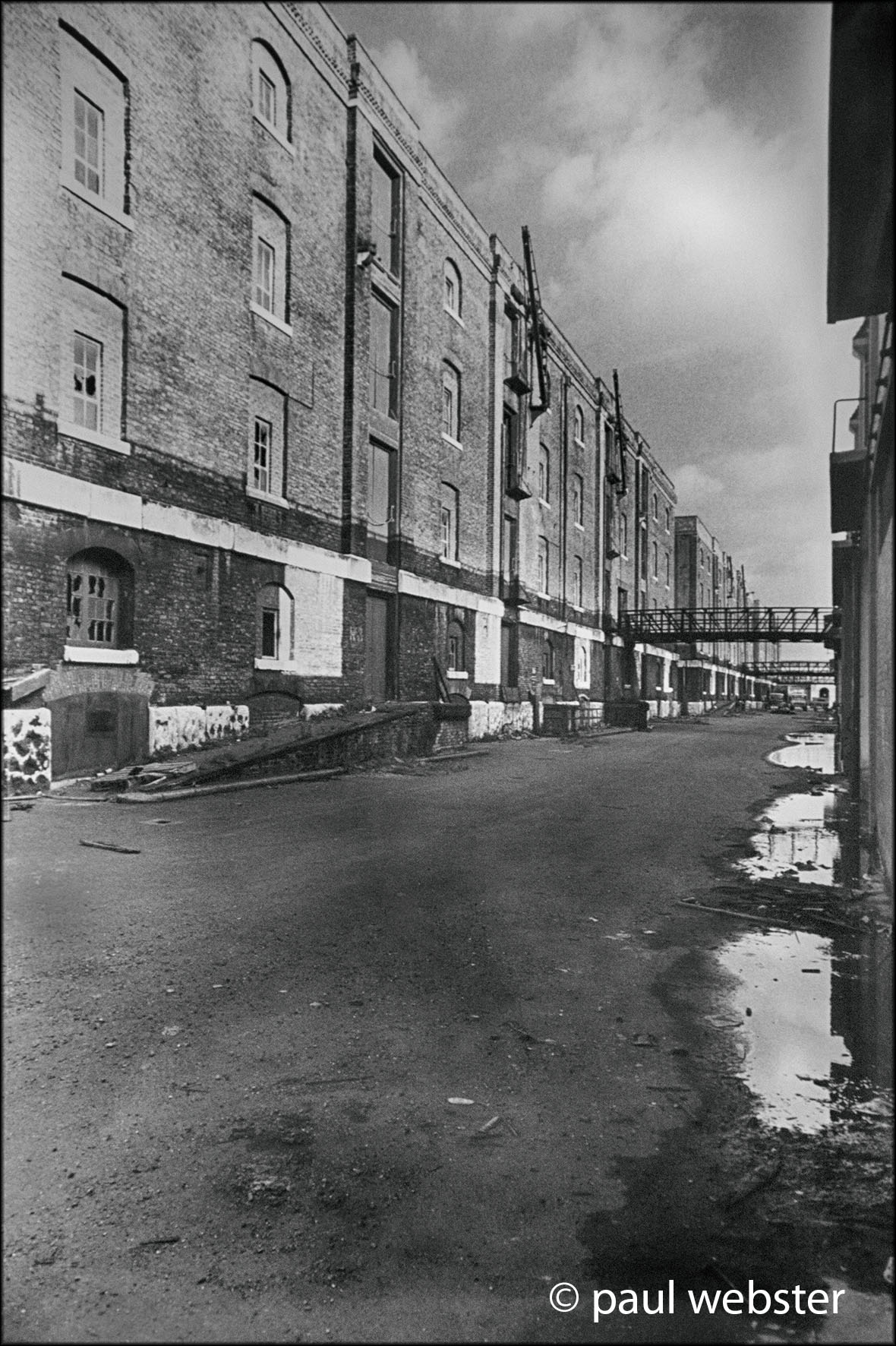
1971. London Docks
Pennington St. warehouses 3, 4 & 5 with at the far end Tobacco Dock warehouses.
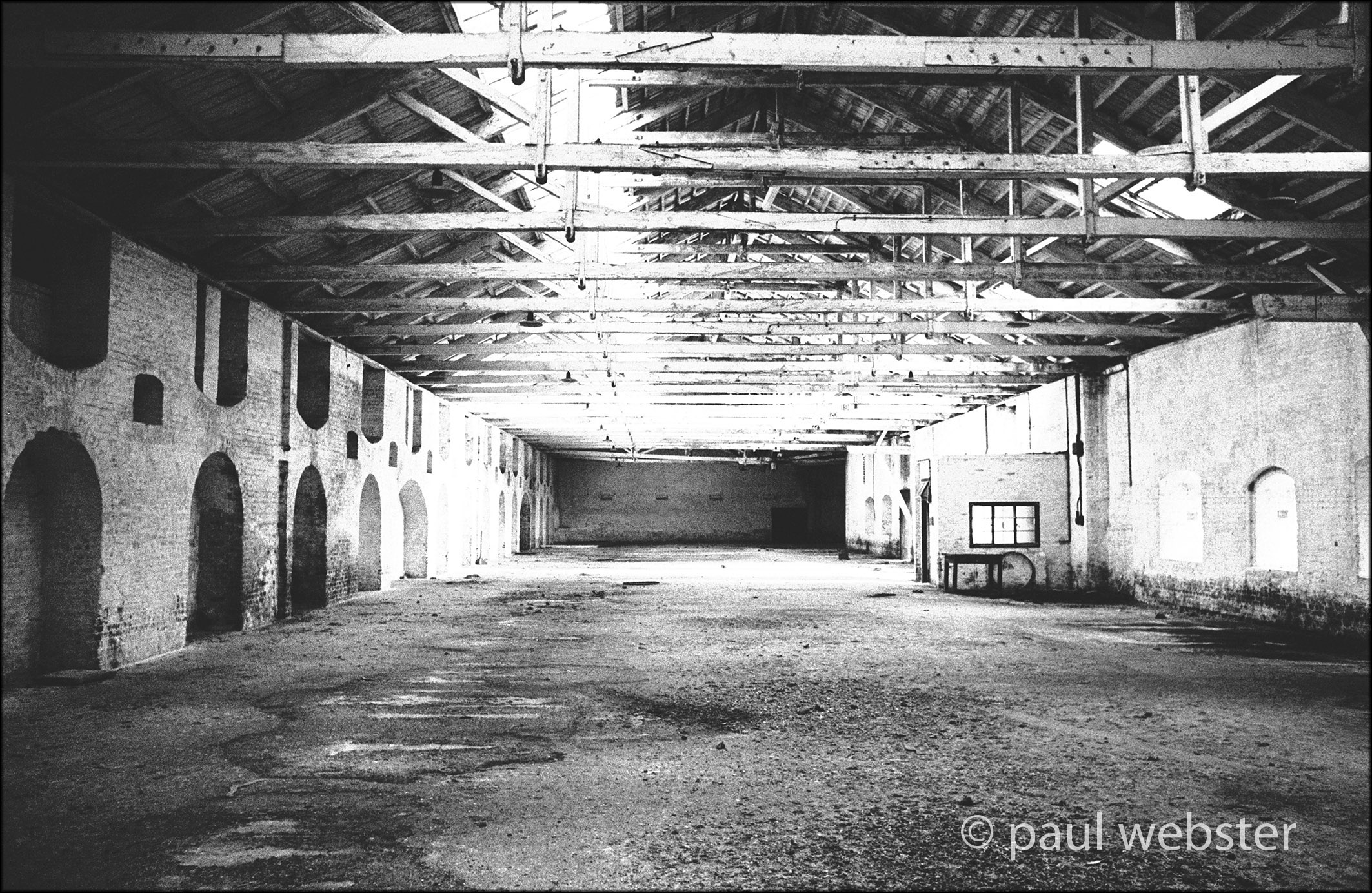
1971. London Docks
Inside Pennington St. warehouses showing the wonderful timber beams, for a short period these were artists studios but they were left decaying until Murdoch’s News International group used them for paper storage and offices.
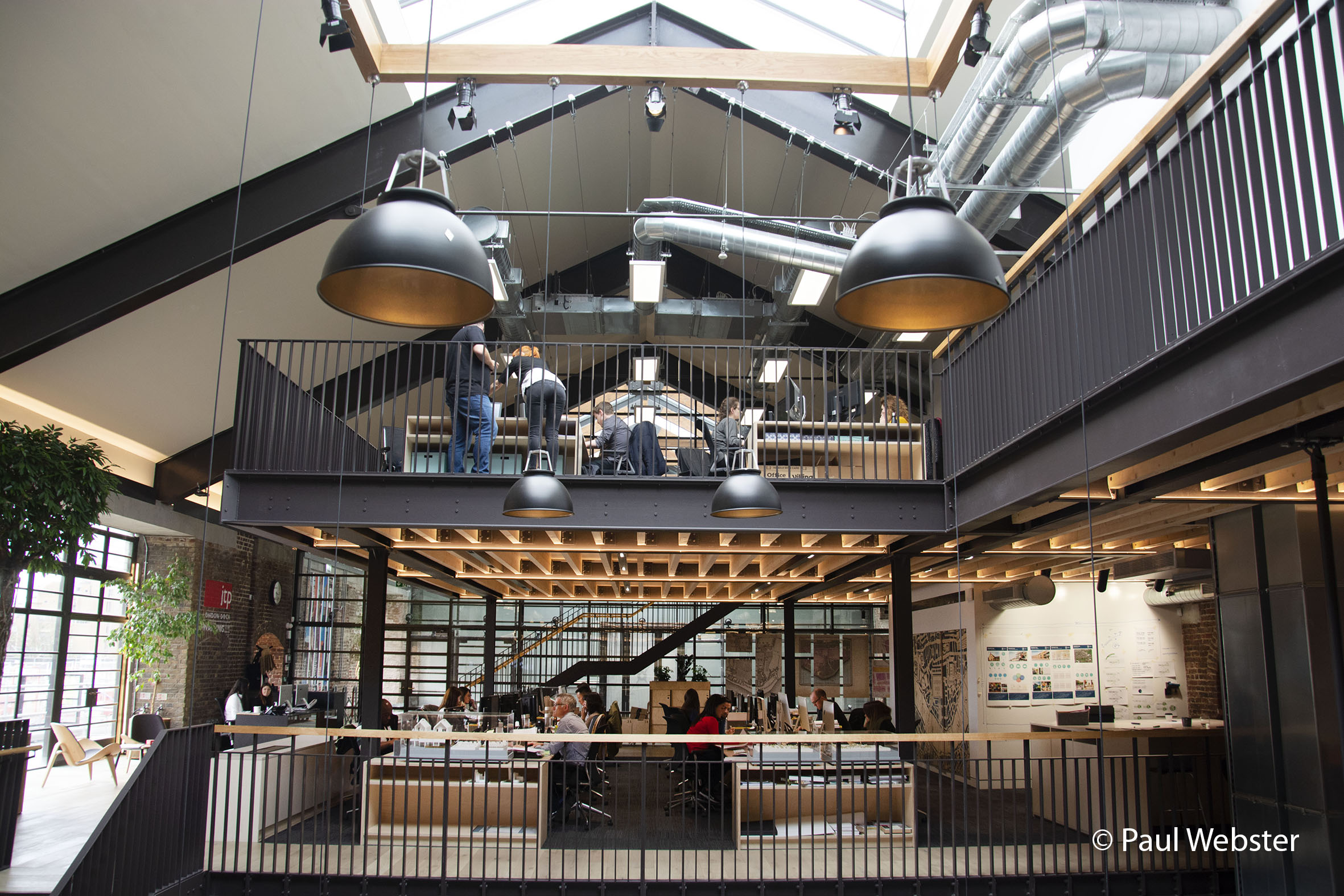
Pennington Street 2019
Unit 5 redesigned , redeveloped and occupied by JTP Design Group.
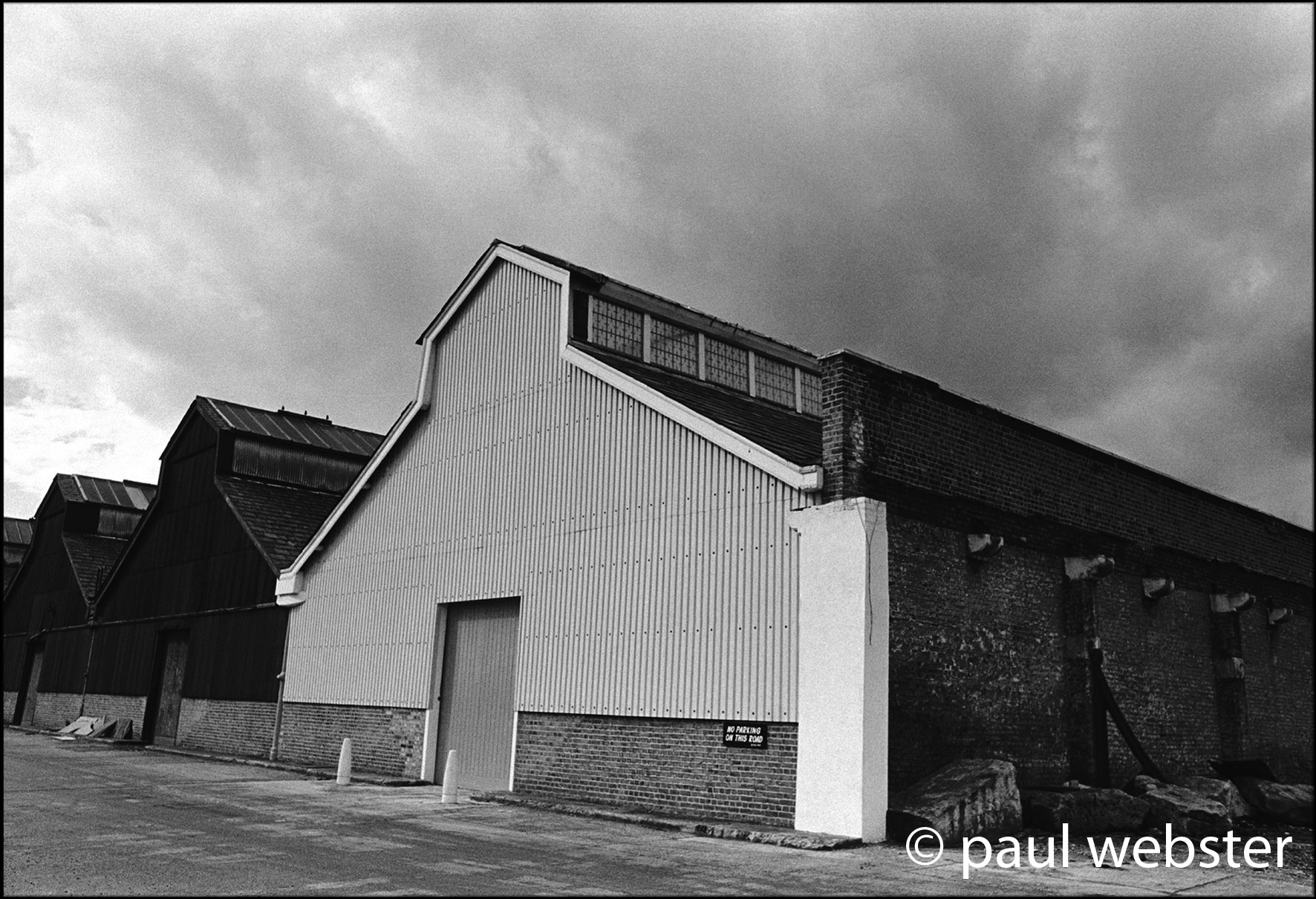
1972. London Docks
Tobacco docks warehouses which housed the old skinfloors.
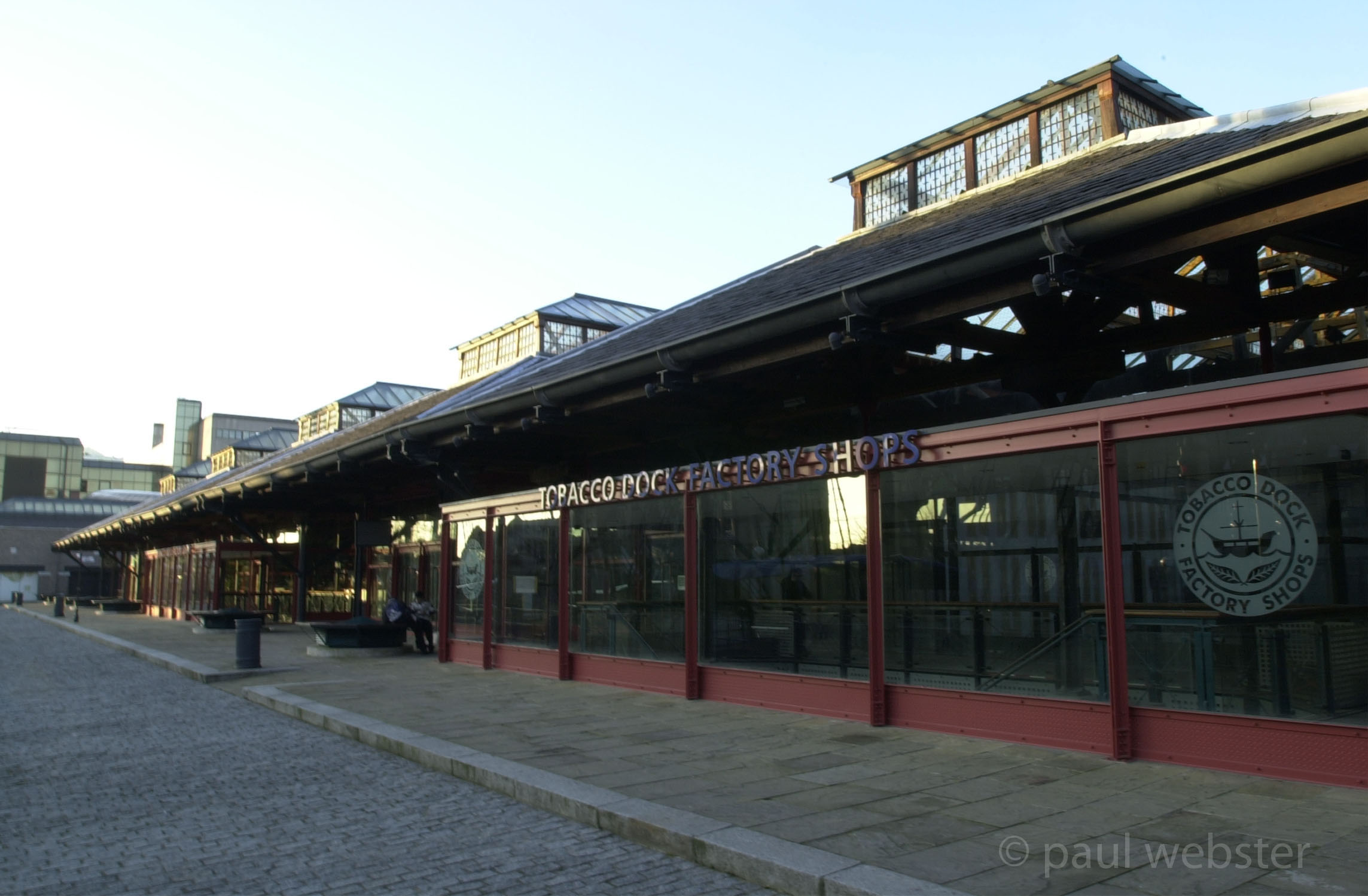
2002. London Docks
The six lantern roofs of Tobacco Docks sit like immoveable heads on a broad pair of Docker’s shoulders . The space is vast , and also deeper than it looks from street level: below the skin floor are brick vaults built on stone pillars. Barrel upon barrel of of wine once lay here awaiting clearance from Her Majesty’s custom and excise.
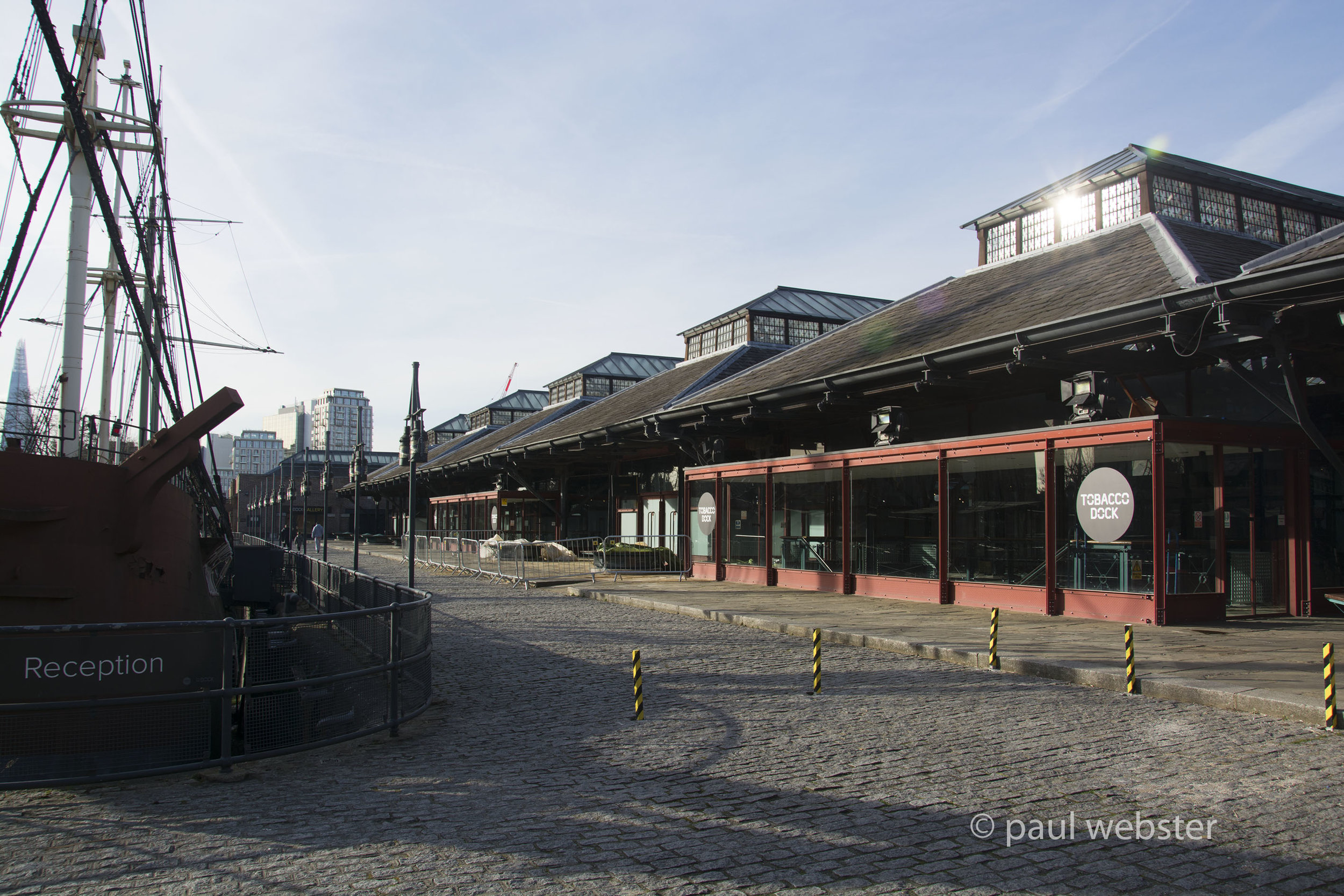
2018. London Docks
Tobacco Dock now an events venue with exhibition ships rusting in their berths. News International's buildings have now been demolished and St.George are creating a large development of luxury apartments, Wapping Village, including a new square.
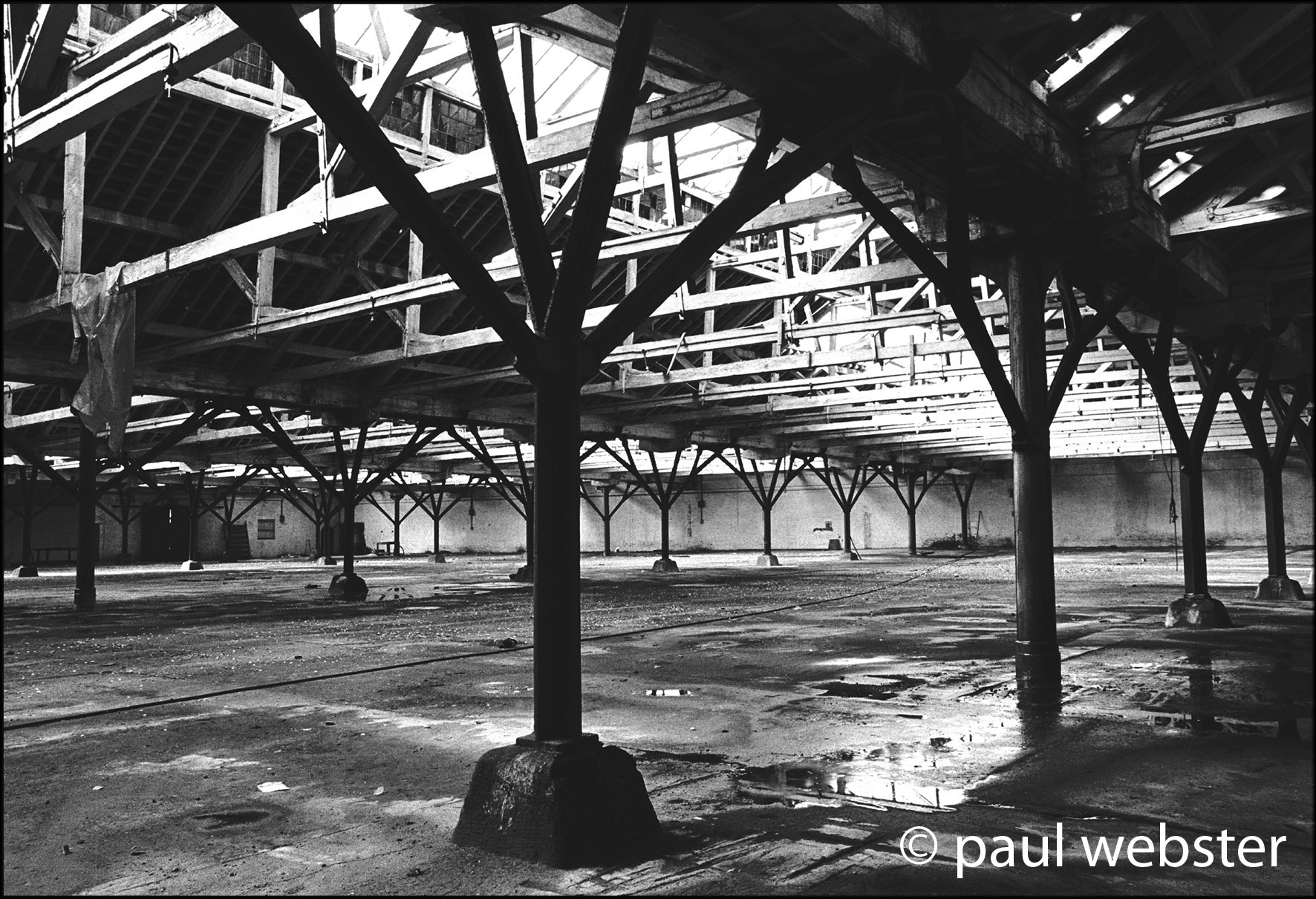
1971. Inside Tobacco Dock , where imported skins were laid to dry.
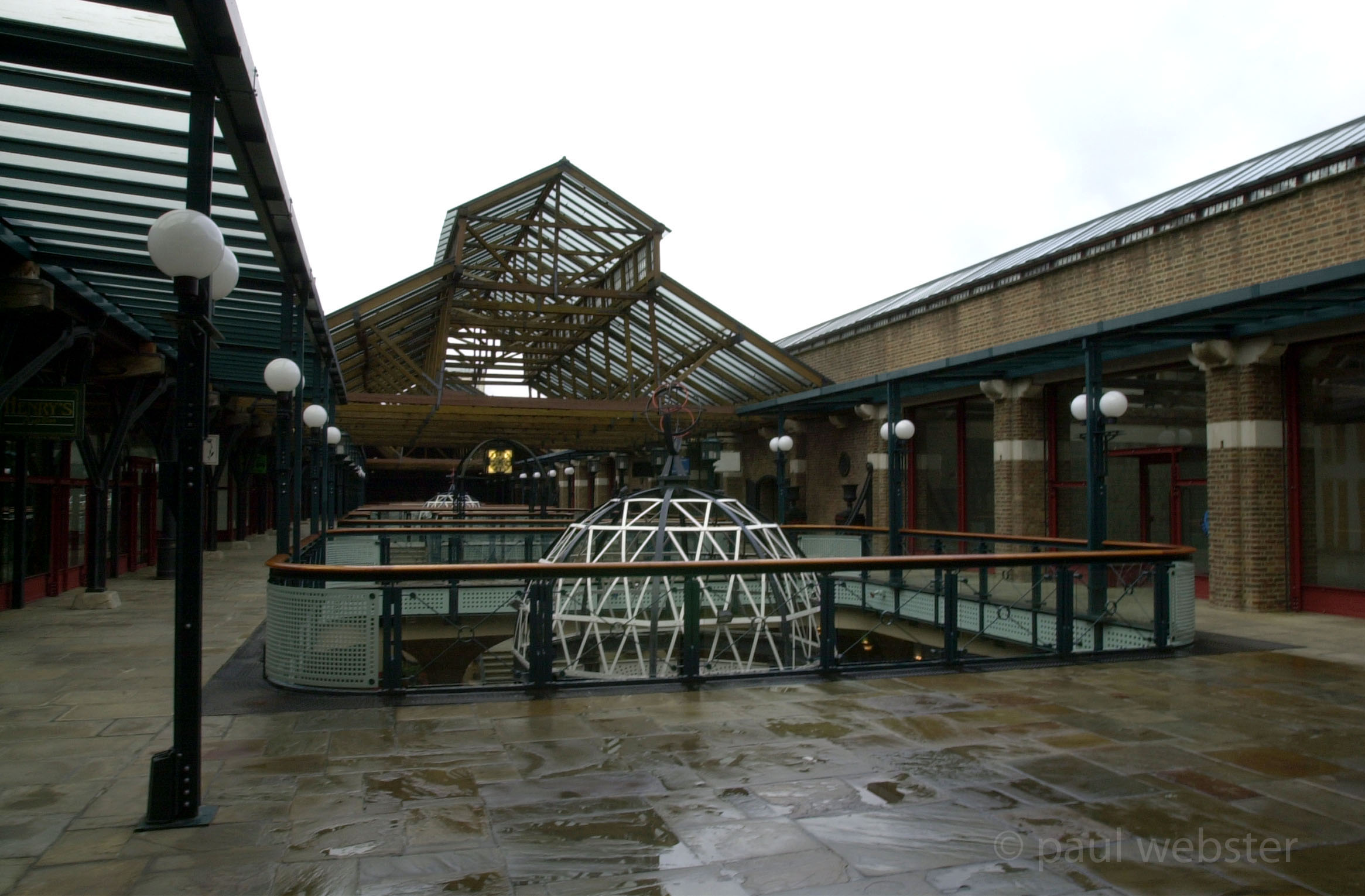
London Docks. 2002
Before it closed , the new Tobacco Warehouse was used for storing furs - hence its 20th century name , the Skin Floor. The old name, or a version of it, was restored along with the site in the 1980s. The original rows of tree-like stanchions still support the elegant roof of Tobacco Dock - but the deserted factory shops make it look even more forlorn than when it was an empty shell.
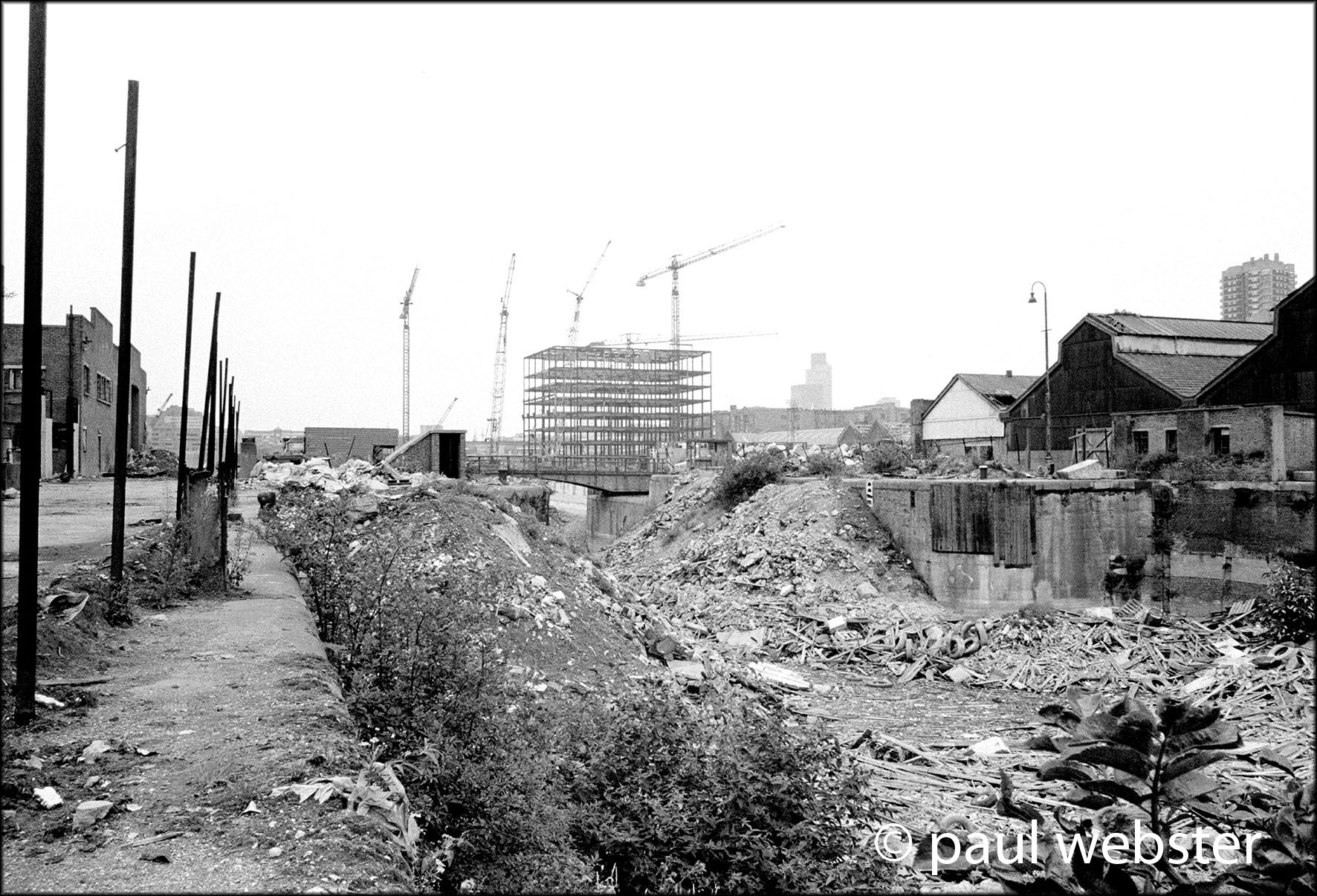
1983. London Docks
1983. Works on the News International site proceeding apace beyond the old Tobacco dock temporarily dried up and disused.
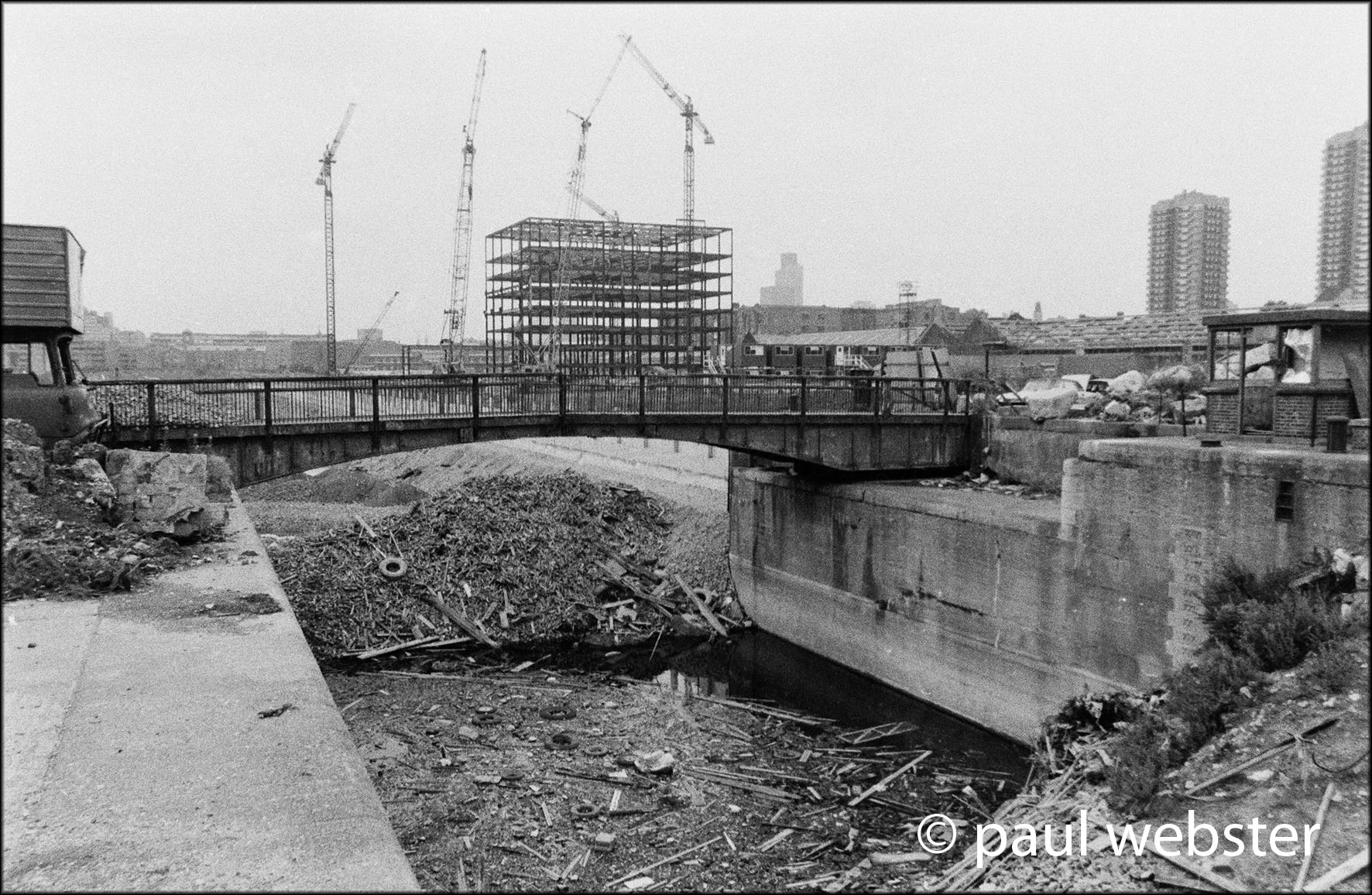
1983. London Docks
View from bridge at Tobacco Dock looking north west towards what was Pennington Street warehouses but now a redevelopment and the new site of News International.
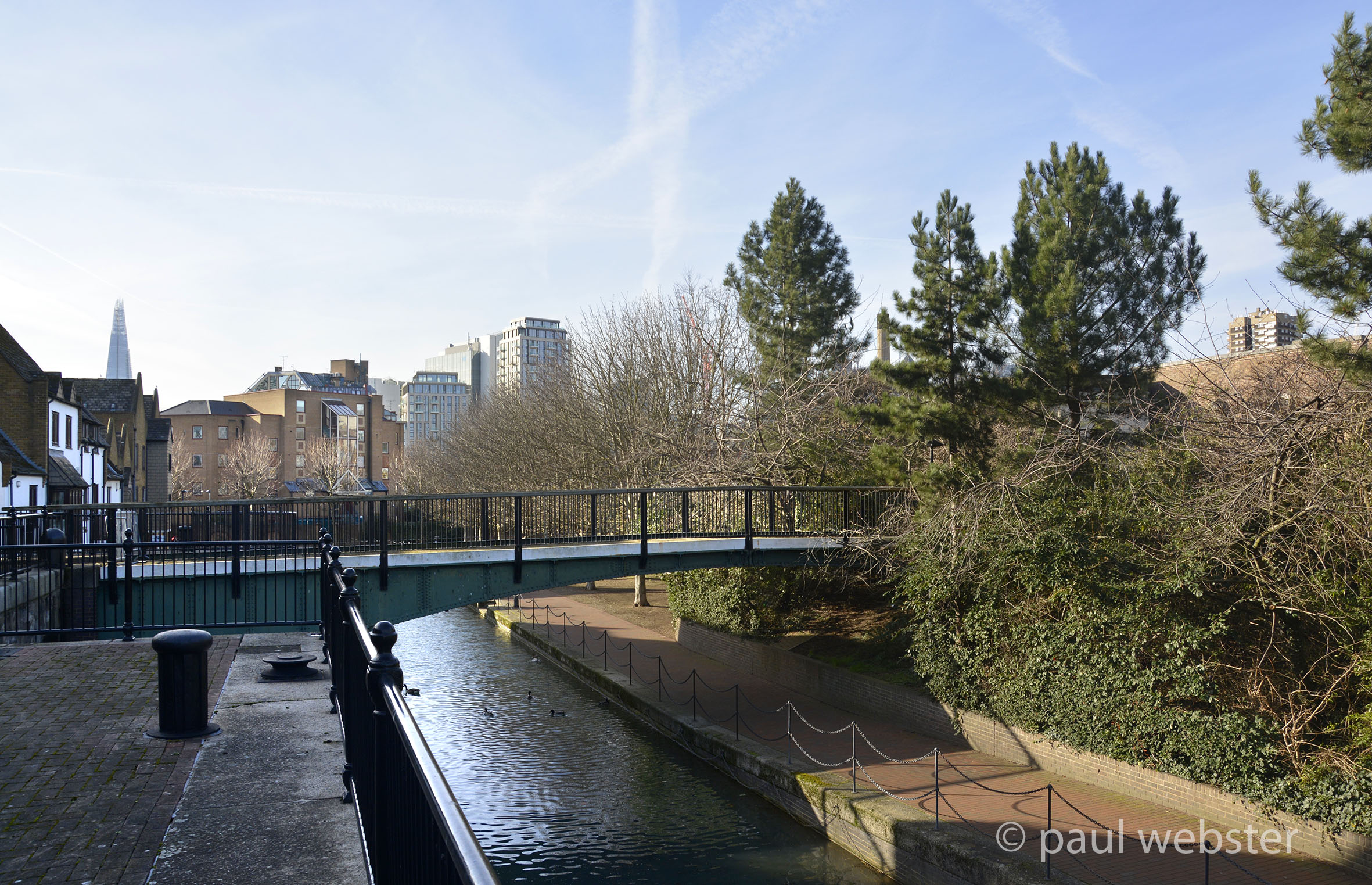
2018. London Docks
View to north east from tobacco dock bridge which is now overgrown on the north side and barricaded . The site of News International has been demolished and St. George have started work on a new development and square.
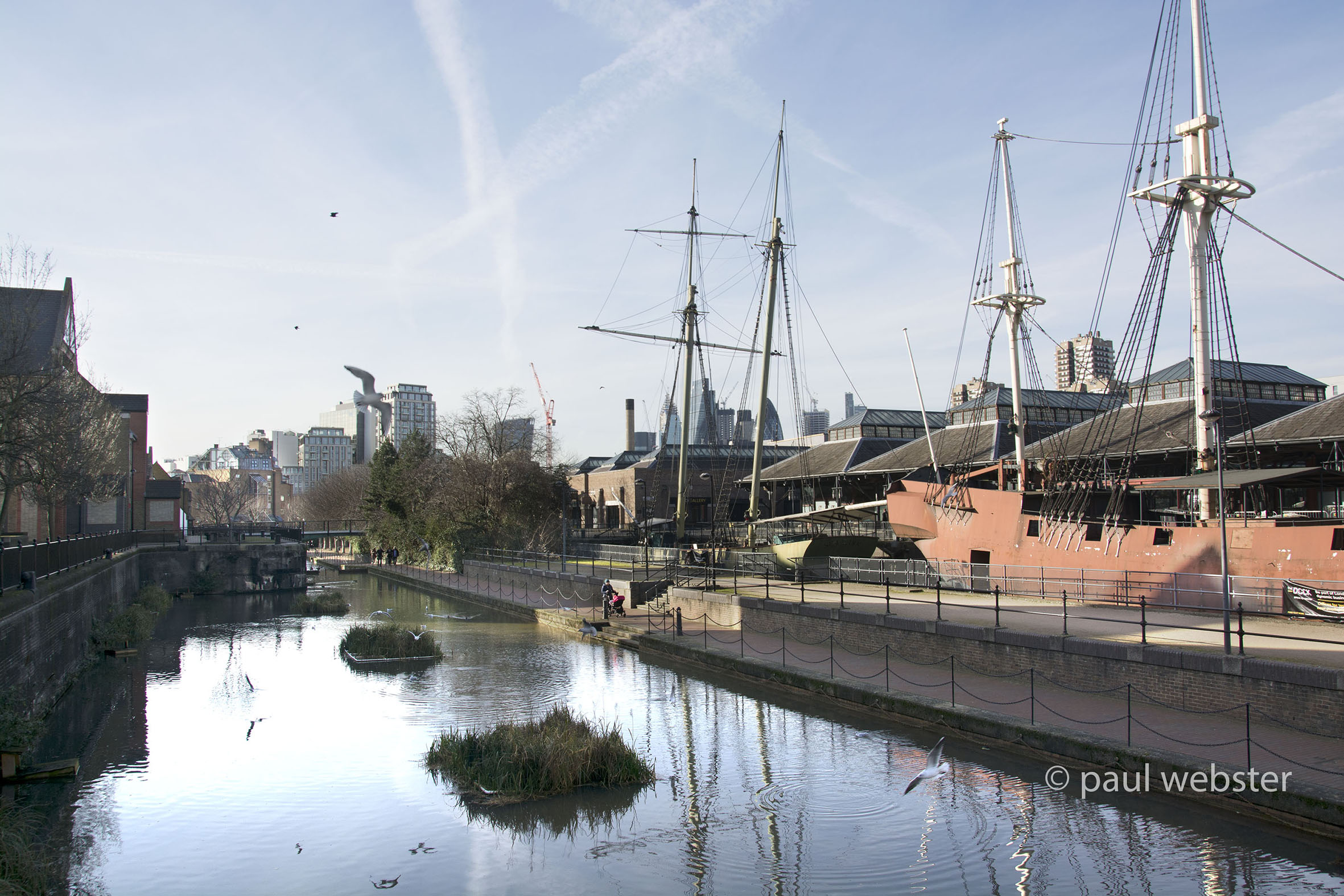
2018. Tobacco Dock
View from Tobacco Dock, now an entertainment venue, to the old News International printing works site now demolished and redevelopment is moving on by St. George.
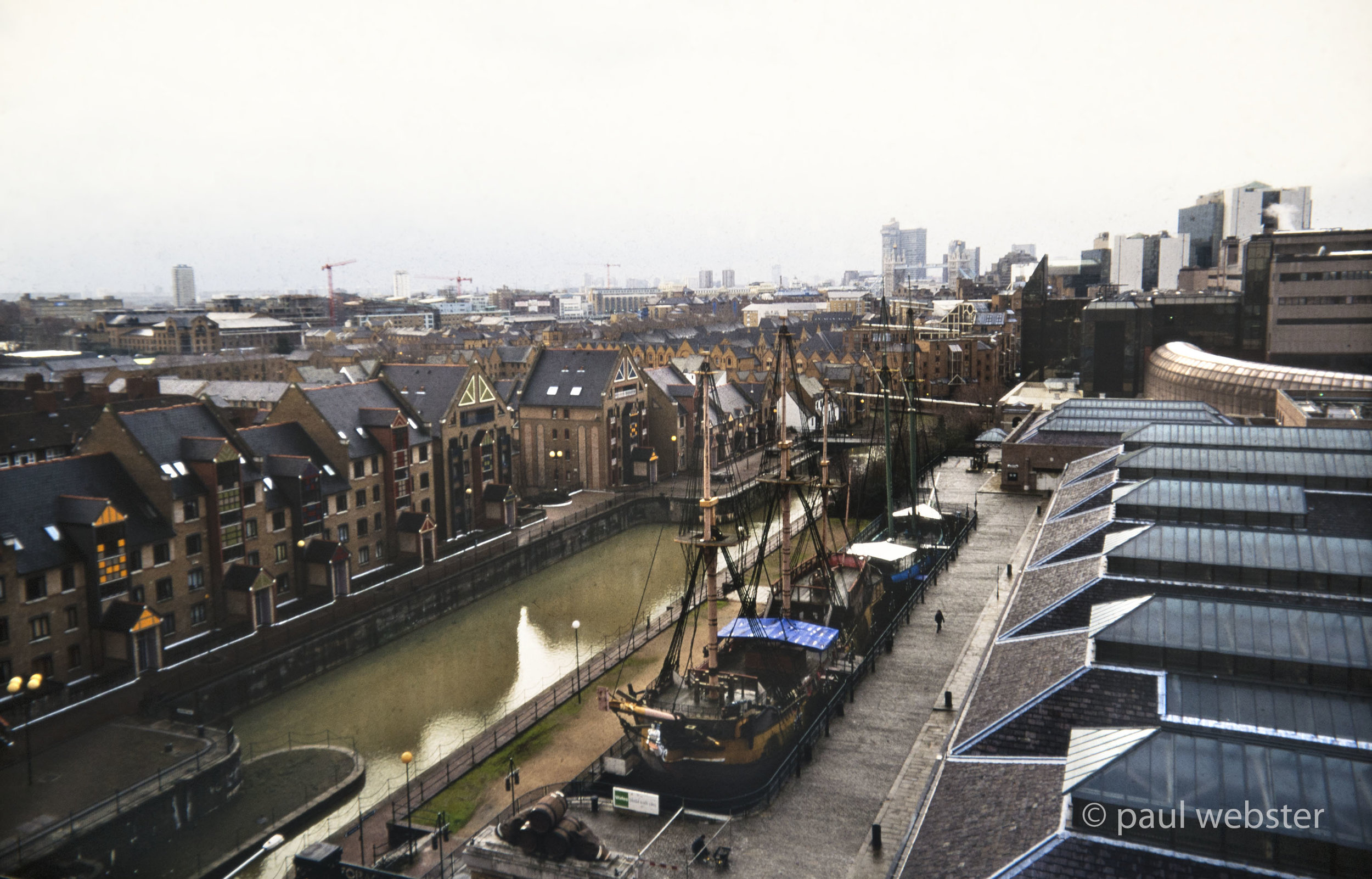
2003. Tobacco Dock & London Dock
Looking West from the eastern dock ( now in-filled and called Wapping Wood ), it would be easy to miss the clues that this was London Dock. Tower Bridge , once obscured by the floating pier in the Western dock , is now almost lost in the jumble of new roofs. Ivory House in St.Katharine’s, and the distant peaks of the bloody Tower have disappeared completely behind the Steel and glass of News International . Only the dark silhouette of the Tower Hotel gives the game away.

2018. Tobacco Dock & London Dock
looking over Tobacco Dock to the site of the old London Dock with the Wapping print works now demolished and awaiting construction of a new residential development next to Pennington St. by St.George who are creating new upmarket apartments and houses and a new square.
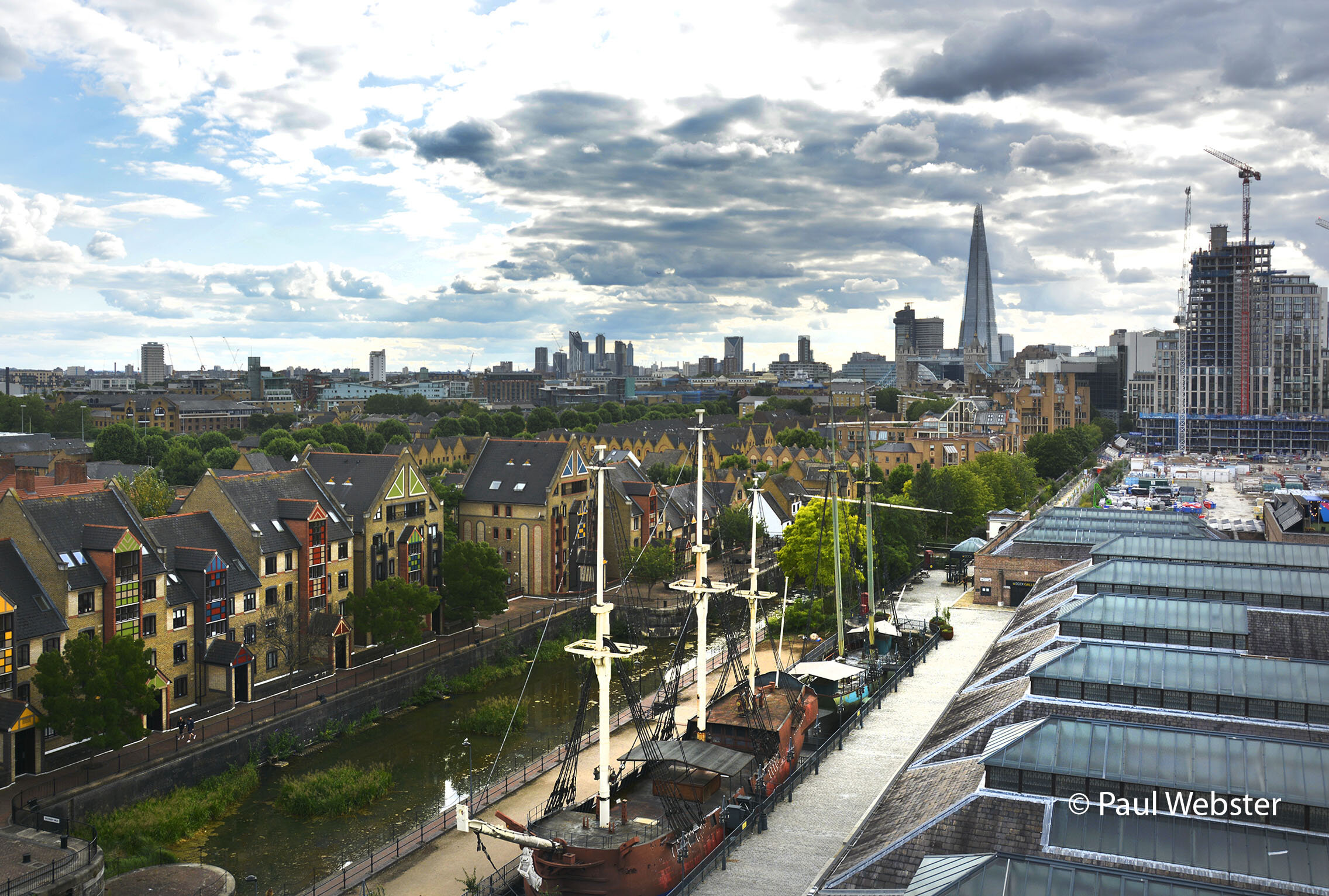
View over London Docks and St.George development 2020
View over London Docks and St.George development 2020 from the roof of Tobacco Docks car park. The first of several new blocks of Luxury apartments is being built next to Gauging Square.

1972. London Dock Wall
The original high dock walls formed a perfect backdrop for local art well before Banksy came along.

2002. London Dock Wall
Part of the housing development in London Dock, some of the wall remains and the bow of the old tugboat can still be seen.
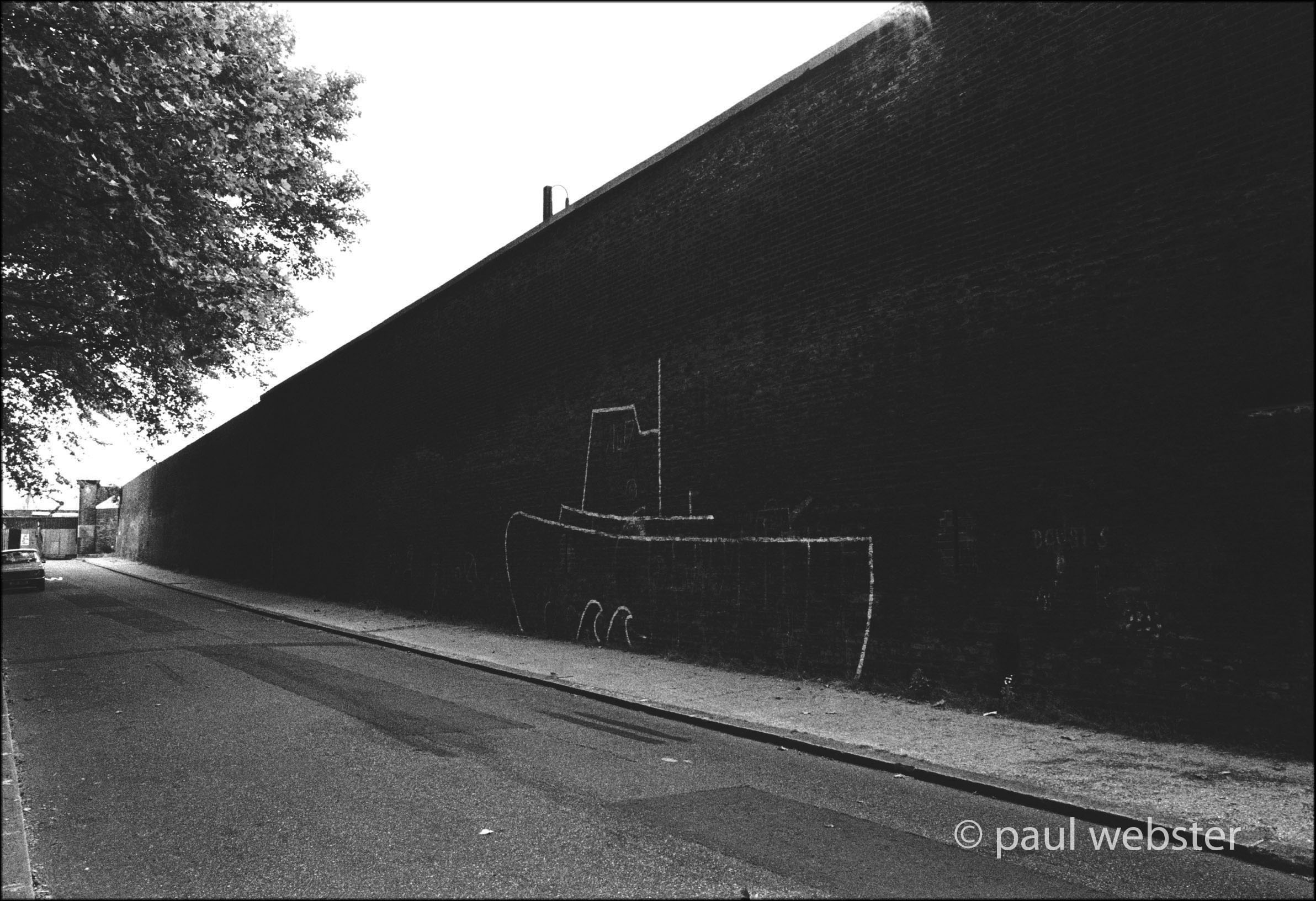
1972. London Dock Wall
Tench st. Wapping , the old dock walls providing security alongside London's warehouses with the painted tug boat sailing by.
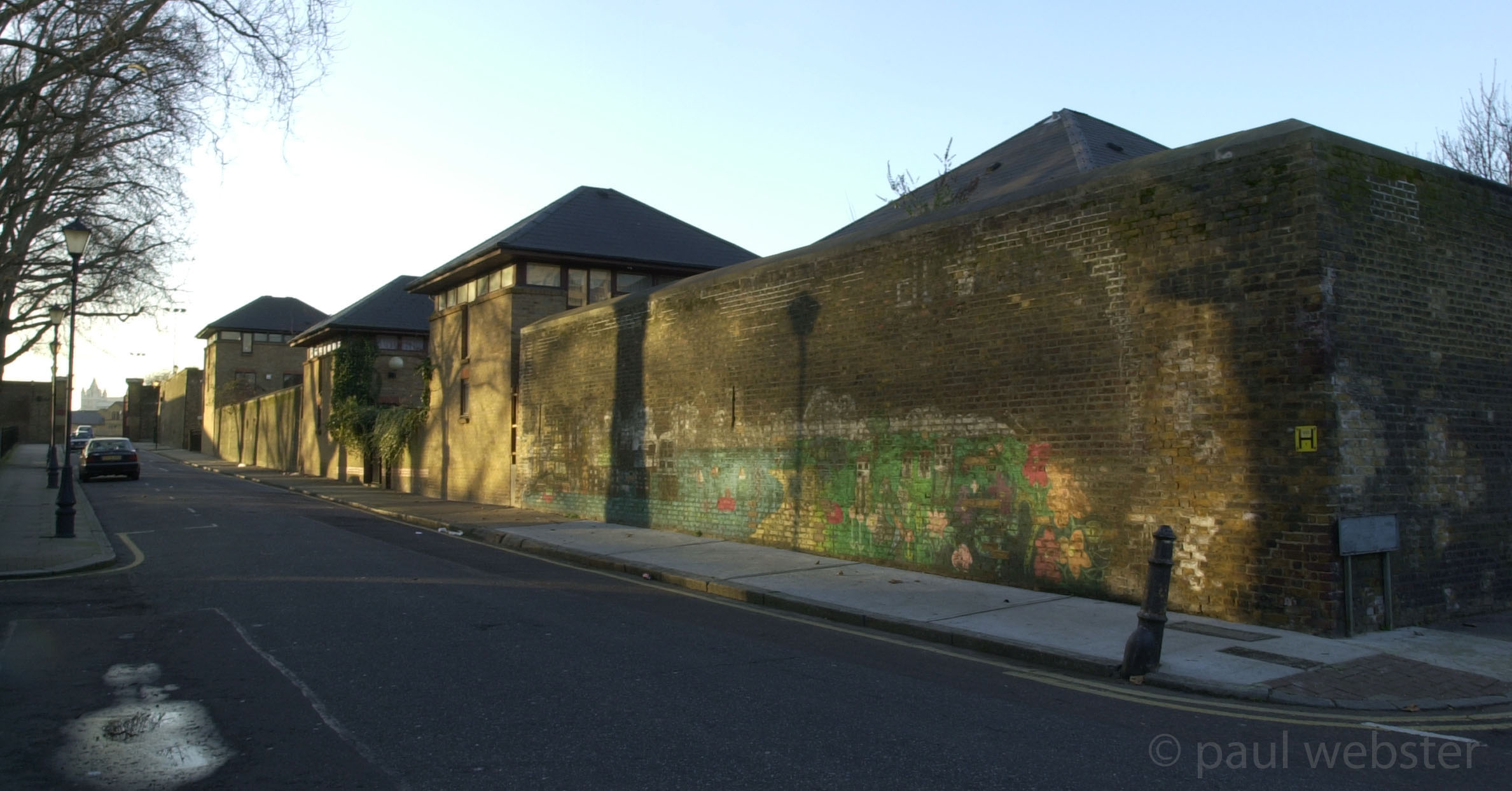
2002. London Dock Wall
Tench st. still providing a backdrop for grafiti and some of the old dock walls still standing.
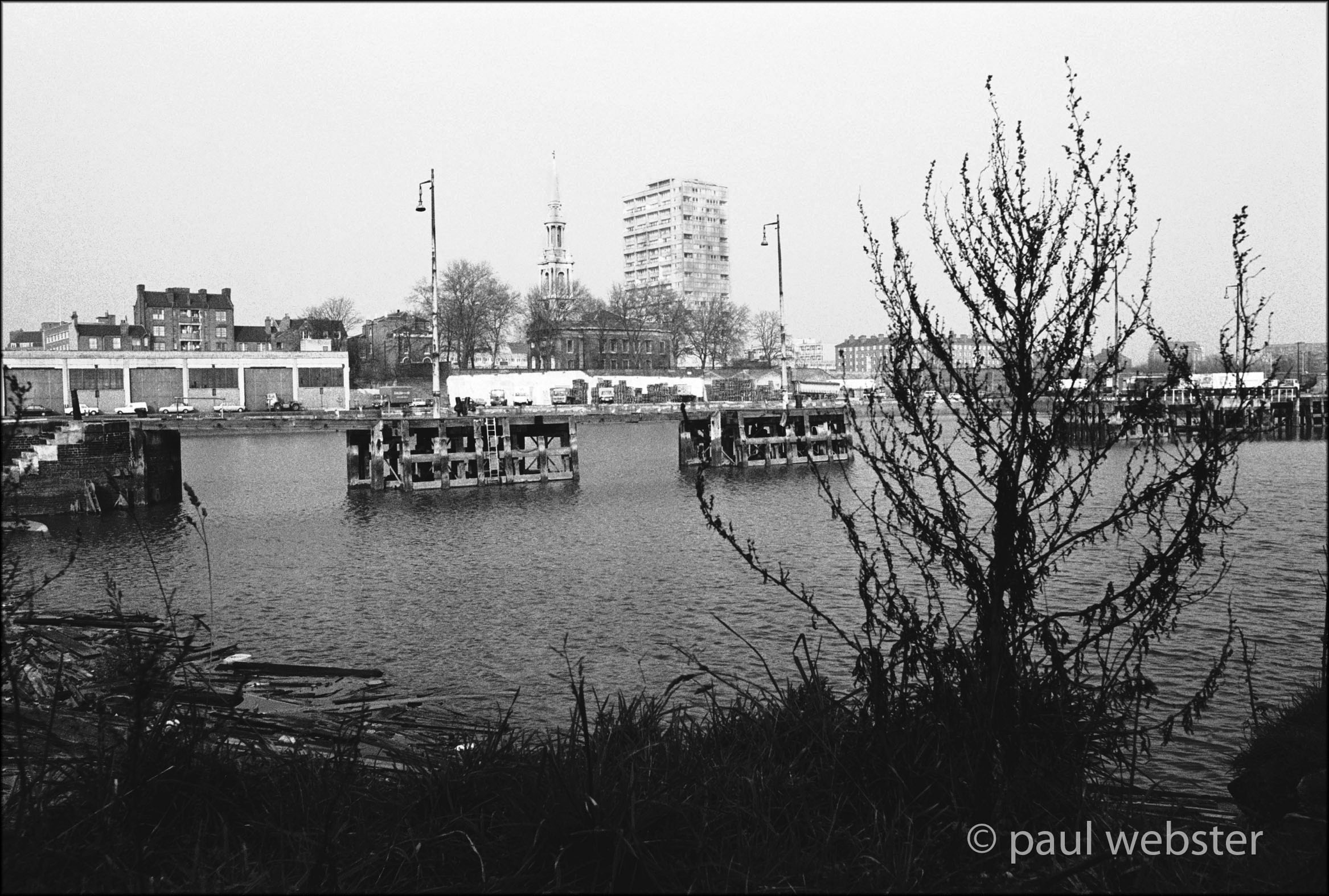
1972. London Dock
Shadwell basin at the eastern end of London Docks providing another river entrance.
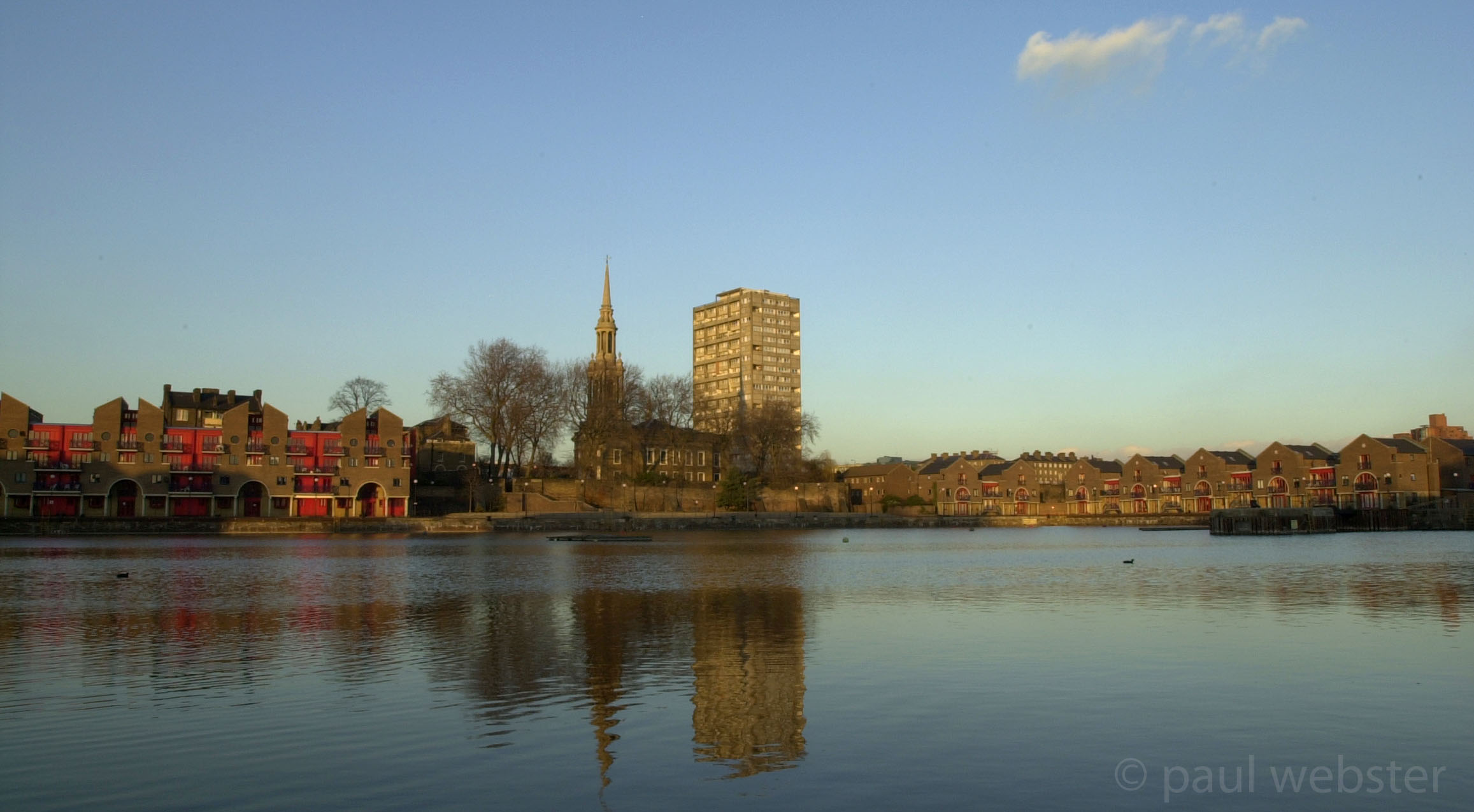
2002. London Dock
Shadwell Basin with St.Paul's church, traditionally known as the sea captain's church, on the other side. It is the largest tract of water still remaining from the old London Docks.

2018. London Dock - Shadwell Basin
Today Shadwell Basin is one the most significant bodies of water surviving from the historical London Docks.
Unlike some of the London Docks which have been landfilled, Shadwell Basin, the most easterly part of the complex, has been retained. It is now used for recreational purposes (including sailing, canoeing and fishing) and is surrounded on three sides by a waterside housing development designed by British architects MacCormac, Jamieson, Prichard and Wright.
The residential buildings are four and five storeys with façades of alternating open arches and enclosed structure, echoing the scale of traditional 19th century dockside warehouses, with a colonnade at quayside.
Shadwell Basin is a popular public route for cyclists, joggers and pedestrians with a walkway alongside the water as part of the linked open spaces and canals between the river and Hermitage Basin near St.Katharine’s Dock to the west.
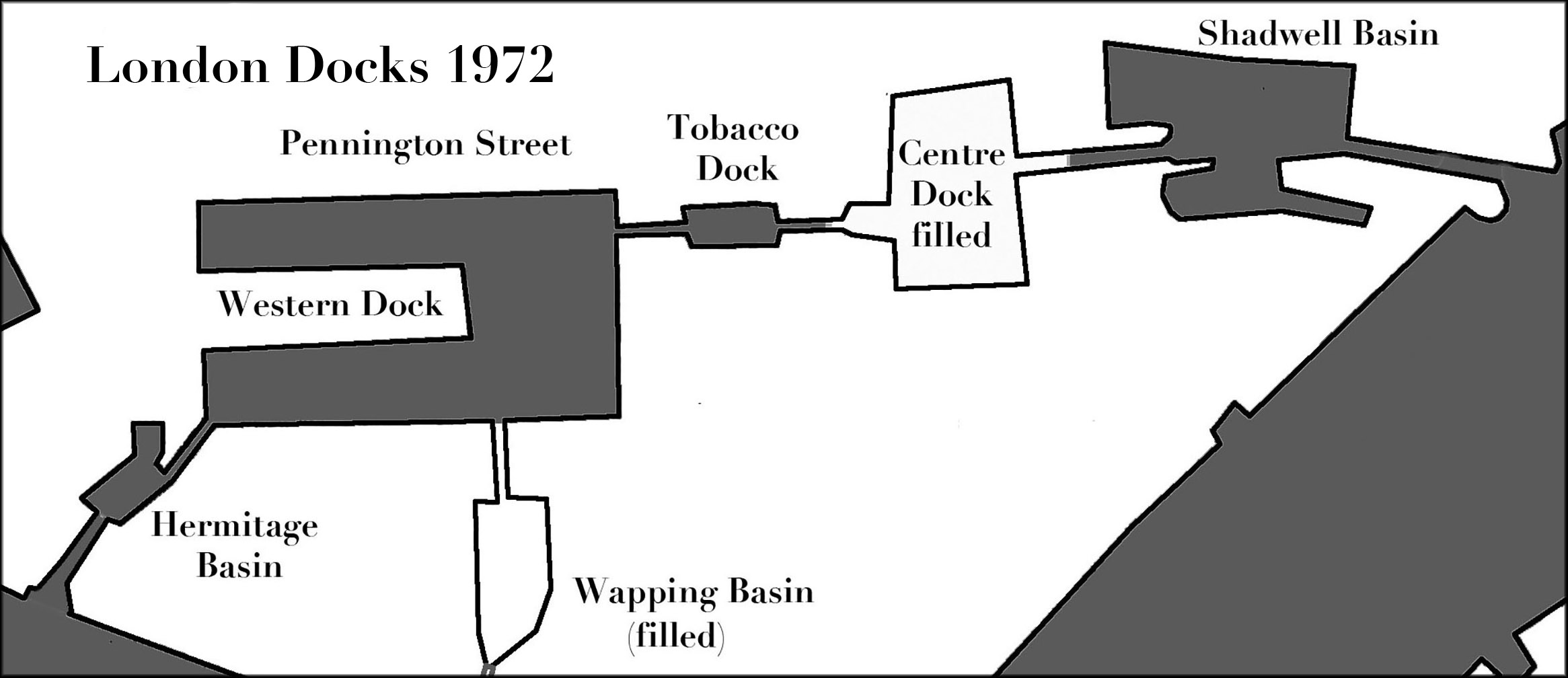
Map of London Docks 1972
as seen in this map the main docks were still in existence with an entrance still available through Hermitage Basin.
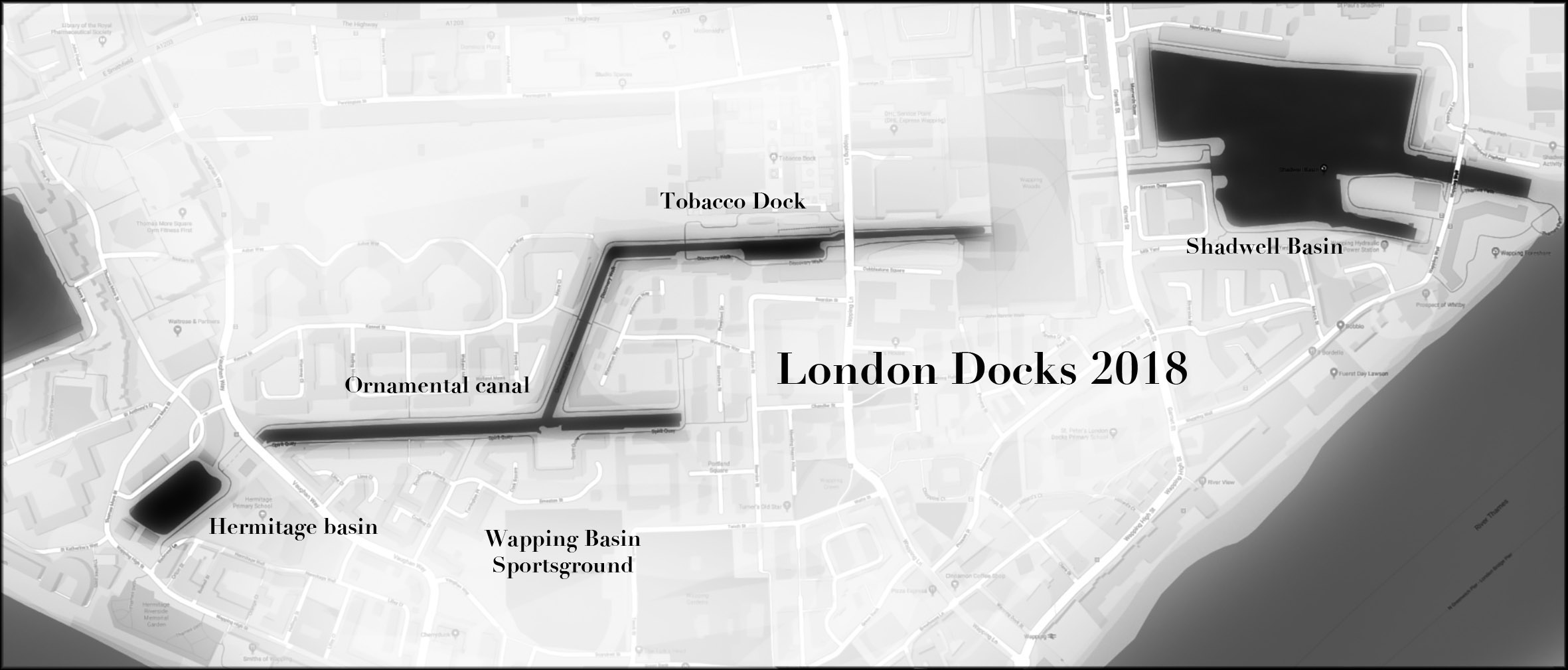
Map of London Docks 2018
The main docks except Shadwell Basin have all been filled and all that remains is an ornamental canal and Hermitage Basin.